















































































INNOVATION YOU COUNT ON QUALITY YOU DEPEND ON SERVICE YOU RELY ON
Phone: 1 (800) 330-0857 | 1 (913) 783-4600
Email: info@magnumenp.com
Website: www.magnumenp.com












Co-Editors
Steve & Suz Trusty
SteveTrusty@TurfgrassSod.org
SuzTrusty@TurfgrassSod.org
Art Director
Jane Tomlinson jane@inkumbrella.com
Director of Meetings
Liz Lonsbrough Liz@TurfgrassSod.org
Policy Consultant
Jonathan Moore jonathanm494@gmail.com Editorial Advisors
John Sorochan, PhD University of Tennessee (warm-season grasses) sorochan@utk.edu
Aaron J. Patton, PhD Purdue University (cool-season grasses) ajpatton@purdue.edu






Officers President
Diane Mischel
DeBuck’s Sod Farm, Inc. – U.S.A. +1-810-653-2201 office@debucksodfarm.com
I wear a lot of hats. Some days I have on my customer service or sales manager hat. Other times I’m outside with my sun protection hat as an equipment operator. I spend time wearing the bookkeeper visor (like the ones senior ladies wear to bingo) while processing statements, paying bills, and recording taxes. Personally, the headband on my human resources fascinator pinches my head at times.
And those are just the hats I wear in my professional life. How do I balance that with all the hats I wear in my personal life? The mom hat, the wife hat, the friend hat, the daughter hat, the vocational hat. Also is there any time that I can just take all the hats off and give my head a break?
Imagine all those hats stacked up on my head with me trying to keep the stack from tipping over. The hot catchphrase these days is “work-life balance.” What does that mean? What are ways to achieve it?
Some people use a clock to designate when to wear each hat. Some people delegate and give a hat to someone else to wear. Some people leave the home hats in the mudroom at home and the work hats on the coatrack at work. Some people keep hats in their purse, so they have the flexibility to switch back and forth when it is convenient. Some people wear two hats at once.
Just don’t forget that the purpose of a hat is to protect your head. All your hats need to serve your life priority. What is your core purpose? What are you called to?
When the hats we wear serve our core function they tend to balance themselves out. Hats that don’t really support our purpose tend to slip off after a while but can leave us with that dreaded hat hair. I usually fix that by taking a break from the hats and just letting my head breathe a little to regain that sense of purpose.
When life increases in intensity, it is easy to get caught up in wearing the same hat every day, or maybe we use cute, fun hats as distractions from stress. As I switch from my warm winter tassel cap to my breezy spring ballcap, I take a minute to look in the mirror to reflect on my “why” and adjust my ponytail.
A hat without a head is just a hat. The hats I wear serve a bigger purpose and sometimes I need to take off my hats and bow my head to remember that.
Yours faithfully,
DeBuck’s Sod Farm, Inc.
Vice President
Daniel Huggett
Columbus Turf Nursery – U.S.A. +1-740-983-6580 danielh@columbus-turf.com
Secretary-Treasurer
Larry LeMay
A-G Sod Farms, Inc. – U.S.A. +1-559-289-2302 llemay@agsod.com
Past President
Bob McCurdy
McCurdy Sod Farms – U.S.A. +1-731-692-3515 mccurdysodfarms@gmail.com
Executive Director
Casey Reynolds, PhD
Turfgrass Producers International – U.S.A. +1-847-649-5555 CReynolds@TurfgrassSod.org
Trustees
Charles Harris
Buy Sod – U.S.A. +1-910-992-6080 charris@buysod.com
Eric Hjort Tater Farms – U.S.A. +1-904-692-2246 eric_hjort@taterfarms.com
Albrecht Knigge
Rasenland – Germany 495 101 915361 knigge@rasenland.de
Lindy Murff Murff Turf Farm, Inc. – U.S.A. +1-281-328-2812 lmurff@murffturf.com
Adam Russell
MVP Genetics – U.S.A. +1-971-718-4525 arussell@mvpgenetics.com
Eric Webb Raft River Sod – U.S.A. +1-208-878-5740 eric@raftriversod.com
Wade Wilbur Sod Shop – U.S.A. +1-913-814-0044 wade@sodshops.com



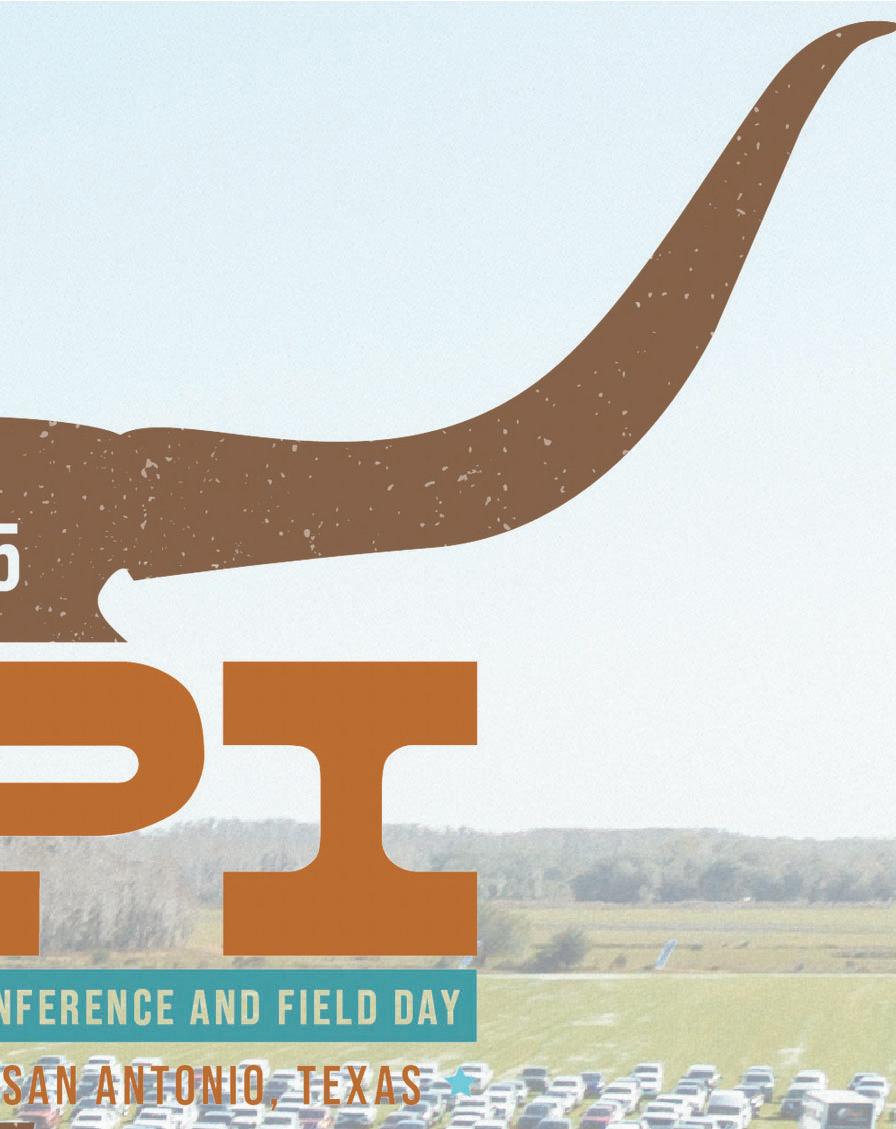





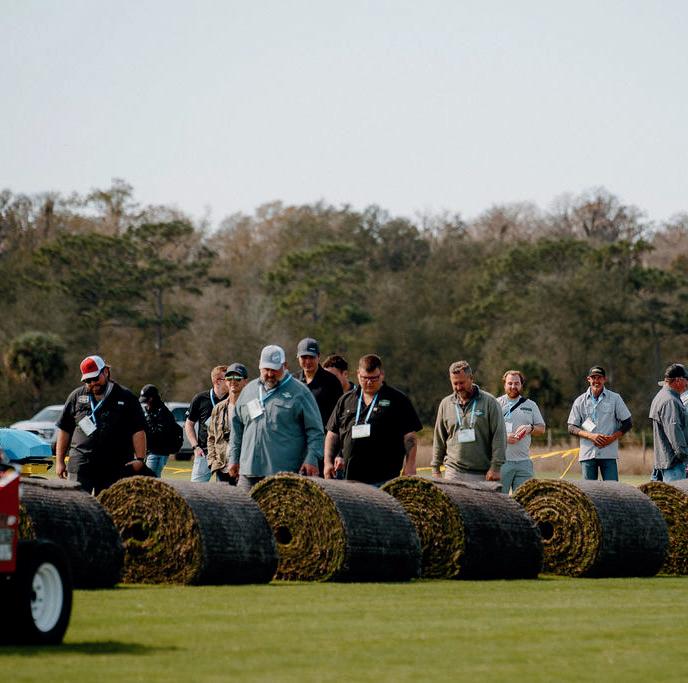
As I sit down to write my Turf News Executive Director’s Message, I sometimes like to scroll back through previous magazines for thought-starters, themes, and other ideas. If I’m being honest, I also do it to make sure I’m not repeating myself. I mean, how many of us can remember something they wrote one, two, three, or four years ago? Believe it or not, I am on my 45th edition of the Turf News Executive Director’s Message and sometimes I think to myself “Have I written this before?”
So I decided to look back at the March/April Director’s Message from the last time we came off an Orlando Conference and was struck by a couple of things, some similar, some different.
Wow, the similarities in our TPI members showing up strong for another conference is striking. Having over 700 TPI producers and suppliers participate in this year’s event? Check! Thanks to each and every one of you who were able to make it, we had a blast. Having another great host farm, this time with Travis Johnson and FloriTurf working their tails off to be a gracious host? Check! Travis and his team were amazing. Thanks so much to him for welcoming us to his farm for Field Day this year. Having another fun night raising funds for The Lawn Institute? Check! Thanks so much to all of our producers and suppliers who made that happen, it was a great night!

Thanks to Diane Mischel and the other Board Members for their participation in the Annual Business Meeting and the direction they routinely provide me and our staff on TPI initiatives. Just as we reported the last time we were in Orlando, we currently have more new publications under production, new member benefits, and of course new public relations and government affairs items we are working on for members in various states.
Finally, another similarity between this Director’s Message and four years ago that is worth mentioning is that we wrapped up the Annual Business Meeting in Orlando in 2020 by inviting everyone to attend the 2021 conference in Austin, Texas. We do that again this year by inviting you to join us in San Antonio, Texas, for the 2025 TPI International Education Conference & Field Day.
Anyone see where I’m going with this yet? If not, what’s the one striking difference between Orlando 2020 and Orlando 2024? Of course, as I wrote the 2020 March/April Director’s Message and we were all flying home from that Conference, we had no idea that Covid-19 was less than a month away from upending the world. As I sit here and write the 2024 March/April Director’s message today, let’s hope the similarities between the 2020 and 2024 Orlando Conferences stop without a pandemic! Having said that, and at the risk of jinxing myself, we’ll see you next year in Texas!
Just as we reported the last time we were in Orlando, we currently have more new publications under production, new member benefits, and of course new public relations and government affairs items we are working on for members in various states.



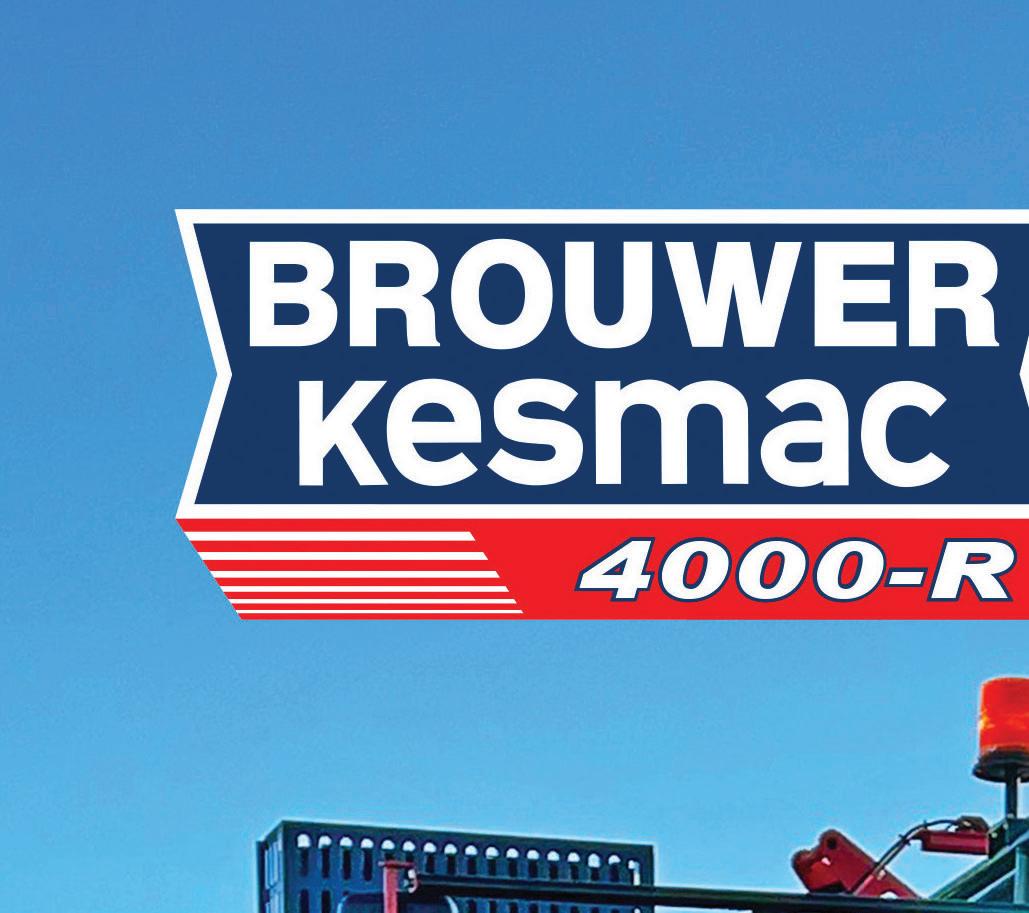











Be sure that you don’t miss out on all the important things going on in the turfgrass sod industry. Renew your membership or join now to be included in the 2024 TPI Membership Directory and to receive all 2024 TPI publications. Please call our office at 847-649-5555, or email Allie Roed at ARoed@TurfgrassSod.org
Want to hear more about the proposed U.S. Sod Checkoff program? See the article starting on page 32 of this issue. See the Turf Industry calendar on page 64 of this issue or visit https://TurfgrassSod.org/ for a list of upcoming events. You can also contact Dr. Casey Reynolds at CReynolds@TurfgrassSod.org or 847-737-1846 to schedule an event near you! The full text of the U.S. Sod Checkoff Program proposal and other information is available at www.SodCheckoff.org/Resources
TPI WORKING WITH COLORADO and UTAH MEMBERS ON LEGISLATION
TPI is working with members in Colorado and Utah to comment on pending legislation around “nonfunctional” grass bans. Stay tuned for more information and let us know if we can help with legislation in your area.
The 2024 class of the TPI Future Leaders Fellowship is underway! Be sure to follow Turf News and TPI Social-Media for updates on this program from our new class of 12 Future Leaders Fellows.
If you haven’t done so already, take time now to check out the NEW TPI website at www.TurfgrassSod.org and browse through it.
Want to see a recap of TPI’s 2023 conferences in Nashville, TN, and Michigan? Visit the new TPI website at https://TurfgrassSod.org/ and scroll to the home page for a recap video.
The process of re-writing the 2006 TPI publication Guideline Specifications for Turfgrass Sodding has begun but it is not too late to provide input. If you use this old publication and have ideas for new content or edits, please reach out to Dr. Casey Reynolds at CReynolds@TurfgrassSod.org or 847-7371846. Also let him know if you have any suggestions for additional publications.
Editor's Note: X was formerly known as Twitter
Turfgrass Producers International


X: @TPITurfTalk
Facebook: @TurfgrassProducersInternational
The Lawn Institute



X: @TheLawnInstitute
Facebook: @TheLawnInstitute
Instagram: @TheLawnInstitute


TPI has an Employee Health Insurance Program for TPI member farms! Check out our TPI website or visit https://www.associationpros.com/tpi-inquiryform for more information on how to apply.
TPI is working with the U.S. Farm Service Agency to develop potential crop insurance plans specific to sod production. If you are interested in learning more or are willing to serve on an exploratory committee, please contact Dr. Casey Reynolds at CReynolds@TurfgrassSod.org or 847-737-1846.
TPI CONTNUES WORK WITH EPA
TPI is continuing its work with the EPA on the proposed 2022-2026 EPA Strategic Plan to make sure that sod farmers are included in important initiatives. TPI is also working with the EPA on proposed changes to the use of the herbicide Atrazine and other pesticides. Please contact Dr. Casey Reynolds at CReynolds@TurfgrassSod.org or 847-737-1846 if you have questions.
ARE YOU REACHING ALL TPI MEMBERS WITH YOUR PRODUCT INFORMATION?
TPI Supplier Members: It is still not too late to take advantage of several opportunities to show and tell TPI Producer Members about your products and services. Check out your options in the 2024 TPI Media Kit. Please contact Geri Hannah at 847-649-5555 or email GHannah@TurfgrassSod.org. The full media kit can also be found online at: https://issuu.com/tpiturfnews/docs/tpi_media_kit_2024
JOIN TPI STUDY TOUR IN ROME THIS OCTOBER
TPI will be conducting a Study Tour to Italy this October. A portion of the tour will include attending the European Turfgrass Producers (ETP) Association event scheduled for October 17-18 in Rome. Details of the ETP event will be available on their website. Stay tuned for more information on the dates and other details, including Registration for this inclusive TPI Study Tour.
FEBRUARY 9-13-2025—SAN ANTONIO, TEXAS
Plan now for another great opportunity for an outstanding get-together with fellow TPI members from all over the world who will be attending the 2025 TPI International Education Conference & Field in in San Antonio, Texas. Mark your calendars now and watch for more details throughout the year, in Turf News, Industry Harvest, and the TPI website, https://TurfgrassSod.org/

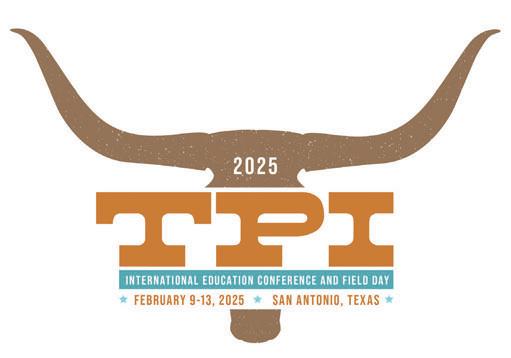

The Lawn Institute sincerely thanks ALL members that have already donated to The Foundation in 2024. In recognition of the Forever Green, Platinum Patron, Gold Benefactor, Green Partner, and 500 Club members, the lists below recognize those who donated as of 1/31/2023.
Hank & Mary Kerfoot (Modern Turf)
For more information contact the TPI office at 800-405-8873 or 847-649-5555.

PLATINUM PATRON/over $10,000
Donkey Forklifts —John Bolton
E-Cargo Tarps, Inc.—Kendrick Martin
GOLD BENEFACTOR/$5,000–$9,999
Bethel Farms—Will Nugent
Brouwer Kesmac—Eric Brouwer
Farm HG—Katie Bishop
Mountain View Seeds—Duane Klundt
TAM NET—Angel Lopez
The Turfgrass Group—Bill Carraway
Valley Irrigation—Andy Carritt
A & W Southern Sod Farm—William Head
Biograss Sod Farms, Inc.—Warren Bell
Columbia Seeds—Ryan Jeffries
Coombs Sod Farms, LLC—John Coombs
Emerald View Turf Farms—Eddie Keeven
Greenhorizons Group of Farms—Ron Schiedel
Heartland Turf Farms—Thomas Keeven, Jr.
Heritage Turf, Inc.—Ron Nixon
Jasperson Sod, Inc.—Randy Jasperson
Milberger Turfgrass, LLC—Arthur Milberger
NG Turf—Aaron McWhorter
Prime Sod—Ryan Thomas
Sales Midwest, Inc.—Tim Wollesen
Saratoga Sod Farm, Inc.—Steve Griffen
Southern Specialty, Inc.—Jim Brewster
Summitt Seed/Profile Products—Ron Edwards
Bentley Turf Farms—Dennis Brigham
Blue Grass Enterprises, Inc.—Michael Loan
Central Sod Farms of Maryland, Inc.—Tom Warpinski
Central Sod Farms, Inc.—Ken Warpinski
Central Turf Farms, Inc.—Keith Wittig
Coosa Valley Turf Farms, LLC—Thomas Wolf
DeBuck’s Sod Farm, Inc.—Diane Mischel
DMG Turf, Inc.—Clay Gardner
Eagle Lake Turf Farm LTD—Eric Heuver
Evergreen Turf, Inc.—Jeff Nettleton
H & E Sod Nursery, Inc.—Darin Habenicht
Huggett Sod Farm, Inc.—Leslie Parrent
JB Instant Lawn, Inc.—Mark Tribbett
Jonathan Green—Barry Green
Laytonsville Turf Farm—Doug Lechlider
McPheeters Turf, Inc.—William McPheeters
Modern Turf, Inc.—Hank Kerfoot
Oregon Turf & Tree Farms—Tom DeArmond
Pine Island Turf Nursery, Inc.—Chip Lain
R. B. Farms, LLC—Robbie Brady
Reid Sod Farm—Randall Reid
SiteOne Landscape Supply—Matthew McCarroll
Sod Solutions—Tobey Wagner
Southland Sod Farms—Jurgen Gramckow
Sporting Valley Turf Farms, Inc.—Matt Wimer
Sumter Sod—Chip Block
Superior Turf & Landscape, Inc.—Thomas Burger
Tater Farms, LLC—Eric Hjort
Thomas Turfgrass—Seth Thomas
Todd Valley Farms, Inc.—Kayla Radford
Trimax Mowing Systems—Larissa Hodgson
Tri-Tex Grass—Mark Graf
Tri-Turf Sod Farms, Inc.—Jason Pooler
Turf Merchants, Inc. (TMI)—Nancy Aerni
Turf Mountain Sod—Linda Bradley
Turf Producers Association—Jenny Carritt
Tvetene Turf—Don Tvetene
Vandemark Sod Farms—Trevor Vandemark
Willowlee Sod Farms LTD—Kurt Vanclief
Young’s Turf Farm—Daniel L. Young
500 CLUB/$500–$999 555.
For more information on how you can support TLI and make a donation in 2024 contact the TPI office at 800-405-8873 or 847-649-5555
You may also donate at TheLawnInstitute.org. Contributions help support turfgrass research, education, scholarships, and natural grass campaign. Donations made in the calendar year will receive recognition in our publications and personal recognition in The Lawn Institute booth at the following levels: FOREVER
Join your peers in contributing to The Lawn Institute to help more consumers tap into the great resources it offers!
The Lawn Institute provides scientific, fact-based information on the value and management of lawns while funding academic research to advance the industry.
The Lawn Institute funds research at universities worldwide to better understand the many benefits of natural grass.
The Lawn Institute’s core mission is to encourage the improvement of lawns through research and education.
The Lawn Institute is a trusted, reliable resource for the latest scientific research on the many benefits of natural grass lawns.
Scan the QR to visit the Lawn Institute website!
You’ll find invaluable resources on Environmental Benefits, timeless Lawn Care Basics and compelling tips in the Helpful Hints Blog. We invite you to check back often to gain access to the most current updates!



The Lawn Institute sincerely thanks ALL members that donated to The Foundation in 2023. In recognition of the Forever Green, Platinum Patron, Gold Benefactor, Green Partner, and 500 Club members, the lists below recognize those who donated as of /2023.
Hank & Mary Kerfoot (Modern Turf)
For more information contact the TPI office at 800-405-8873 or 847-649-5555.

Donkey Forklifts —Lon Kraft
Heritage Turf, Inc.—Ron Nixon
Magnum—Steven Dove
Prime Sod—Ryan Thomas
Cameron Financial —Darryl Yochem
Turf Mountain Sod, Inc.—Linda Bradley
GREEN PARTNER/$1,000–$4,999
Saratoga Sod Farm, Inc.
SelecTurf, Inc. —Jim Keeven
Seven Cities Sod, Inc.—Keaton Frye
Tater Farms —Eric Hjort
Tri-Turf Sod Farms, Inc.—Jason Pooler
Turf Merchants, Inc. —Nancy Aerni
Turf Producers Association —Jenny Carritt
A-G Sod Farms —John Addink
Bethel Farms —Will Nugent
Biograss Sod Farm —Don Heslop
Buena Vista Turf Farm—Mike Selman
Columbus Turf Nursery —Daniel Huggett
Coombs Sod Farms, LLC —John Coombs
DeBuck’s Sod Farm, Inc.—Diane Mischel
DeBuck's Sod Farm of NY, Inc.—Greg DeBuck
Emerald View Turf Farm —Eddie Keeven
FireFly Automatix, Inc. —David Collier
Heartland Turf Farms —Tom Keeven, Jr.
Jasperson Sod Farm—Randy Jasperson
Landmark Seed Company —on behalf of Larry Humphreys
Laytonsville Turf Farm —Doug Lechlider
McCurdy Sod Farms—Bob McCurdy
Milberger Turfgrass, LLC—Arthur Milberger
Modern Turf, Inc.—Hank Kerfoot
Murff Turf Farm, Inc.—Lindy Murff
Progressive Turf Equipment —Luke Janmaat
Sales Midwest, Inc.—Tim Wollesen
GOLD BENEFACTOR/$5,000–$9,999 —Steve Griffen —Jason Pooler —Jason Pooler
500 CLUB/$500-$999
A & W Southern Sod Farm —William Head
All Seasons Grass, Inc.—Irene Gavranovic-Sipes
Blue Grass Enterprises, Inc. —Michael Loan
Central Turf Farms, Inc.—Keith Wittig
Coosa Valley Turf Farms, LLC —Donald Coyle
DMG Turf, Inc.—Clay Gardner
Eagle Lake Professional Landscape Supply—Eric Heuver
Evergreen Turf, Inc.—Jeff Nettleton
Green Acres Turf Farm —Gary Youmans
JB Instant Lawn, Inc.—Mark Tribbett
Landmark Seed Company—Ben Boehme
M & M Turf Farm—Mike Wagner
McPheeters Turf, Inc.—William McPheeters
Oregon Turf & Tree Farms—Tom DeArmond
Pine Island Turf Nursery, Inc.—Chip Lain
Quality Turf, Inc.—Morgan Heimbach
R.B. Farms LLC —Robbie Brady
Reid Sod Farm—Randall Reid
m —Randall Reid
Sod Solutions —Tobey Wagner
Sporting Valley Turf Farms—Matt Wimer
s —Matt Wimer
Todd Valley Farms, Inc —Wayne Thorson
Vandemark Sod Farms—Trevor Vandemark
s —Trevor Vandemark
Young’s Turf Farm—Daniel Young
West Coast Turf—John Foster
Winstead Turf Farms Bobby Winstead Far
ms —Bobby Winstead
s —Graham Simmons
For more information on how you can support TLI and make a donation in 202 contact the TPI office at 800-405-8873 or 847-649-5555
You may also donate at TheLawnInstitute.org. Contributions help support turfgrass research, education, scholarships, and natural grass campaign. Donations made in the calendar year will receive recognition in our publications and personal recognition in The Lawn Institute booth at the following levels:
FOREVER GREEN/LEGACY GIVING PLATINUM PATRON/OVER $10,000 GOLD BENEFACTOR/$5,000—$9,999
GREEN PARTNER/$1,000–$4,999
500 CLUB/$500—$999
Early Spring
Green-Up Faster Than Other Bermudas

Lower Water Usage
Shade Tolerance Improved Over Other Bermudas


Exceptional Cold Hardiness for the Northern Transition Zone
Wear Tolerance to Heal Fast from Divots & Foot Traffic Pro-Level Density for Golf Courses & Sports Fields
Are you hoping to hire but facing a shortage of potential employees? So is nearly every other business throughout the U.S. and around the world. Help Wanted signs and messages are everywhere. Many retailers offer applications onsite, followed by immediate review, and if the applicant is qualified for a position, an immediate interview. Other companies are using their advertising funds to broadcast their job openings on radio and television. And social media is buzzing with job opportunities. It’s hard to compete with all that.
According to the January 2024 report from the U.S. Bureau of Labor Statistics, the U.S. economy added 2.7 million jobs in 2023, which is more than in the years preceding the pandemic. Wages also “increased 0.4 percent on a monthly basis and 4.1 percent over last year.” The wage gains have outpaced inflation, though pay increases have slowed in recent months.
These figures were updated on February 1, 2024. The Hill Business & Economy e-newsletter reported American businesses added 353,000 jobs in January, soaring past expectations and signaling strong economic growth. The jobs gain was almost double the 180,000 economists had predicted, and as the U.S. Labor Department further reported, the unemployment rate remained at 3.7 percent. In addition, wages again rose faster than inflation, up 0.6 percent in January. Annual wage growth was up 4.47 percent. The Hill further reported, “Many economists think 3.5 percent annual growth is more in line with the Federal Reserve’s target of 2 percent inflation. But strong wage and economic growth have coincided with falling inflation, which dropped to 3.4 percent in December of 2023, down from its 9 percent peak in June 2022.” And added, “The labor market isn’t cooling off as many economists had predicted.”
On January 30, 2024, the U.S. Bureau of Labor Statistics announced that the number of job openings on the last business day of December 2023 stood at 9.0 million. This figure is down from a high of 12.0 million in March 2022. Earlier in the month, on January 16, the Bureau had announced the unemployment rate held at 3.7 percent at the end of December, with the number of unemployed persons essentially unchanged at 6.3 million. This brings the ratio of job openings to unemployed workers to 1.43.
The current figures compare favorably to the figures at the end of December 2022, when the Bureau reported 11 million open jobs compared to the unemployment figures at that time resulting in the ratio of job openings to unemployed workers to 1.9. That means there were nearly two job openings for every job seeker in the U.S. Now there are closer to one and a half jobs for every job seeker.
But even with improving numbers, finding new employees is a challenge, not only for sod producers but for the entire green industry. The Irrigation Association (IA) 2023 Green Industry Outlook survey reported that contractors faced another year where their businesses were impacted by labor limitations. Regardless of what part of the green industry respondents come from, bringing in and keeping staff was one of the toughest challenges this season. Asked to name the top three barriers to growing their business, 72 percent of survey respondents identified labor availability and retention; 43 percent cited economic conditions, and 33 percent cited insurance/employee compensation.
The challenges extend throughout the ag market, too. On December 27, 2023, The Scoop (thedailyscoop.com) reported a new survey from the Minneapolis Fed found ag bankers rank labor availability as a top concern for their farm clients. The survey, which was conducted with ag bankers from the ninth district (Minnesota, Montana, North Dakota, South Dakota, and Wisconsin), found the issue is viewed as a “serious challenge” for 63 percent of respondents and a minor challenge for the majority of the remaining 37 percent. In response to the question on how this compares to past conditions, 39 percent of respondents said labor availability has gotten “much worse” over the past five years and 44 percent said it’s “a little worse.”
The Scoop reported the Minneapolis Fed attributes this challenge to the region’s low influx of migrant workers and its aging workforce. While those are certainly strong contributing factors, the labor issues in this sector are multifaceted and complex.
But even with improving numbers, finding new employees is a challenge, not only for sod producers but for the entire green industry.
Consider the general public’s perceptions about agricultural and green industry jobs. You’ve probably heard it more times than you can count—hard work, tough conditions, long hours, little status, and probably low wages, too. Today’s job conditions are much better than those perceptions, but they’ll only know that if you get the word out.
Your location also impacts your labor pool. Sod production obviously takes large expanses of land, which ties you to the rural environment. Even though your company is within delivery range of your major markets, those non-family members working on your farms must travel to get there. So you’re competing with those companies that can offer their employees a five- to ten-minute commuting range. But you wouldn’t be in this business if you couldn’t face challenges. You know what your company has to offer. It’s up to you to deliver that message to those who can help you grow.
Find the best fit. Not an okay fit, not a “good enough for now” fit, not a “might work out over the long-term” fit— but the best fit. Why? Consider the effort it takes to target the skills/attributes/attitudes you want, identify a potential employee, connect with them, interview them multiple times, negotiate wages and benefits, and train them. Do you really want to go through all of that for an “okay” or “good enough for now” or “might work out over the long-term” fit? If your answer is anything other than no … you’d better reconsider … because that attitude will doom you to the perpetual process of finding, hiring, training—and replacing.
In the article, “5 Hiring Trends,” Stephanie Vozza of Fast Company reports multiple hiring consultants recommend moving beyond the typical job description to focus more on skills. They recommend developing a database of skills specific to your company. These consultants expect companies to “start identifying individuals with the agility to learn new skills and who can problemsolve and communicate their findings to others.”
That’s a great starting point. After all, how do you expect to find the best fit if you haven’t identified your ideal candidate's learning capacity, skill set, physical ability, attitude, and work ethic (level of commitment)?
Doing this effectively means asking yourself, and your hiring team, some tough questions. Do you have the same criteria for all positions within your company or do they differ depending on the job the individual will be doing? Have you developed an employee handbook that spells out your expectations? Does your company offer opportunities for employee growth and advancement? If so, is that clearly communicated to your existing staff as well as your potential employees? How does your company culture (how you do what you do – and why!) play into the ideal candidate decision?
Once you have determined what you’re looking for you’re ready to tackle the quest for the best fit. Look back at your search for employees over the last few years. Identify what worked well—and what didn’t. Then fine-tune your process to make it even more effective. Your best fit is out there. It’s up to you to make that connection.

Throughout the green industry, labor costs rank at or close to the top in company expenses. In the Irrigation Association’s 2023 Green Industry Outlook survey, when participants were asked to report their business’s two largest expenses. Labor costs were cited by 82 percent of respondents. The next most frequently cited expense was equipment, tools, and materials – which was named by only 37 percent of respondents.
While most of you pay your employees, “prevailing” wages or above, the public’s perception of low wages for the green industry segment does hit home. The Economic Policy Institute (EPI) is an independent, nonprofit think tank that researches the impact of economic trends and policies on working people in the United States. On November 9, 2023, EPI issued an email reporting it had released a new Low Wage Workforce Tracker showing the current and historical number of workers paid low wages in the U.S. economy, by different wage thresholds and demographic groups. The green industry falls into the agriculture category which is identified as one of the industries where workers are most likely to make low wages. To connect with the tracker, go to the link that follows. https://www.epi.org/low-wage-workforce/
So, as you conduct your employee search, be aware of that perception. Do your research on the prevailing wages for your area to better gauge what those competing with you for new hires are offering so you have an up-to-date comparison. Also, compare your benefits package to those of your likely competitors. Though money still talks, many of the younger generation in the current job market are looking at the balance of wages and benefits, not just wages.
Why do you love what you do? Why do your current employees enjoy working for your company? Why do your long-time customers come back again and again? What does your company do to enhance your community? How does what you do benefit the environment? Put all that together and you have a wonderful story to tell. So share it.
Tap into technology. The equipment used in the fields for sod production is eons beyond what it was in 1967 when Turfgrass Producers International was first formed as the American Sod Producers Association (ASPA). Automation has continually improved the way you get your work done. Now autonomous machines are being introduced that will further streamline your operations. Similar technology has transformed the office from phone calls, orders on paper, and whiteboard work scheduling to text, email, and computerized, web-based integrated systems. While all this is just the daily routine to you, it’s impressive to those unfamiliar with the industry— including your potential employees.
Explore options other than a full-time employee to take on some of the repetitive, but essential, tasks in your operation. One idea you might explore is the three-person tag team to take on the work equivalent to one full-time employee. Three high school teachers, all with master's degrees in mathematics, have been tag teaming to fill the slot of one mower operator for a local golf course. And they approached the golf course superintendent with the idea. Though they have different personalities, they share the same educational level, skill set, and work ethic. From the perspective of the work accomplished, they’re “interchangeable.” They receive the work assignment for the week and make sure it is covered. They handle the who will be there when factor, and they track their hours, making sure none of them reach full-time status. But who puts in those hours varies from week to week, giving them the flexibility to spend time with their families and travel for vacations. They work summers, and weekends, and often cover for holidays and sometimes evenings, depending on their schedules. The only disadvantage is they all must plan their availability around the school year schedule.
Your fellow sod producers have shared similar options for this type of one-job-multiple-worker arrangement that has worked for them with high school and community college sports teams during the team’s offseason. In most of these cases, the scheduling of who works when is coordinated by the coaching staff, with one of the coaches as the designated contact. Often this labor pool is used for manual labor, such as sod installation, with the work hours considered part of the athlete’s conditioning program.
Finding the best fit won’t be easy, but it will be well worth the effort.
Explore options other than a full-time employee to take on some of the repetitive, but essential, tasks in your operation.
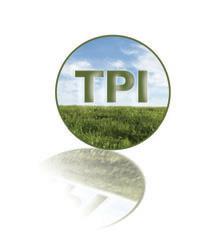





Toxic employees can destabilize a workplace, depress team morale, and erode a company’s bottom line. Supervisors need to identify damaging behavior and take corrective actions that turn negative workers into positive performers. In the longer range, employers must create supportive workplaces by recognizing employee achievements as well as failures.

Wilber always arrives late. Margareta constantly badmouths her employer. Joseph talks over others in meetings.
Welcome to the employees from hell. Their toxicity creates a negative workplace, causes resignations by colleagues, and threatens the bottom lines of the best businesses.
What to do? Here are the actions supervisors can take to turn negative workers into positive performers.
Wilber is chronically late for work—and always has a good excuse. Chronic lateness inconveniences colleagues and creates a dysfunctional workplace. “Dealing effectively with Wilber is a two-step process,” said Eric Cormier, Manager of HR Services at Insperity (Insperity.com). “The first is to find out the real reasons why Wilber struggles to arrive on time. The second is to help him connect the dots to solve the problem.”
Keep in mind that Wilber may be just as frustrated as you by his chronic tardiness. “The fact that Wilber always has a good excuse indicates either that he cannot see the bigger picture for his tardiness, or he is resisting taking accountability,” said Cormier.
Either way, Wilber needs help. Schedule a one-on-one conversation with the goal of shifting Wilber’s perspective so he begins to recognize the scope of his problem. Be open and non-judgmental so Wilber feels comfortable revealing any personal challenges that are affecting his performance. “Set your frustrations aside and be genuinely curious about why Wilber is late so often,” said Cormier.
Start by pointing out that he is rarely on time and ask why that might be the case. If recurring immovable conflicts, like school drop-offs, are the issue, then schedule flexibility might be the solution. “Shifting Wilber’s official arrival time thirty minutes later could make Wilber a punctual employee overnight, and reduce his stress level, too,” said Cormier.
Perhaps Wilber has personal challenges that are causing the problem. “ Some mental health conditions can make it more challenging for employees to arrive on time,” said Cormier. “Gently ask him about how he is doing, giving him the opportunity to share without pressuring him to open up. Regardless of Wilber’s answer, his manager can remind him of any available personal resources such as an employee assistance program (EAP).”
The meeting should, above all, be solutions-oriented “Be clear that the goal of the conversation is to step away from excuses, understand the bigger picture, and come up with a lasting solution.”
Bonus tip: Schedule follow-up meetings so Wilber is held accountable for improvement and can request needed support.
Sandy keeps saying “It’s not my job” when asked to do a task. Recalcitrant employees who appeal to the constraints of their “job description” can frustrate the best of managers. The traditional solution was to throw down a gauntlet: get to work or get fired. But that can create morale problems that affect team performance and erode profitability. Instead, undertake a three-step plan designed to uncover the hidden reason for Sandy’s behavior.
Step one: Assess the situation. “What does your history with Sandy tell you in terms of her willingness to get a little bit stretched in the work she does?” poses Bob Verchota, senior consultant at RPVerchota & Associates, Minneapolis. “Is her reluctance something new, or did it start at a certain time? And is it related to one specific task or many?” The answers to these questions can provide clues to possible causes.
Step two: Ask Sandy for input about her motivations. “Have a frank conversation with Sandy,” suggests Verchota. “Cover what you know about her work habits, as elucidated in Step One. If she has been willing to perform extra duties in the past, what has changed in the organization?”
Step three: Determine solutions. Rather than impose a solution from above, ask Sandy to suggest a path forward. If she feels her skills are inadequate for the new duties, that can be solved with additional training. If the problem is personnel clashes, this can be solved with counseling for all involved.
Bonus tip: Remind recalcitrant employees that most job descriptions include a phrase requiring employees to perform “other duties as assigned.”
Joseph is in the habit of “talking over” others in meetings. Failure to deal with an overbearing team member can create morale and productivity problems when employees feel their contributions are belittled.
“Have a sit-down meeting with Joseph and explain how his behavior is affecting other people,” suggests Deanna Baumgardner, President at Employers Advantage (employersadvantagellc.com). “Say something like, ‘We've noticed you’re talking over people, you're talking loudly,
and interrupting. We need to give other people the opportunity to share. Here's what we expect from you.’ Then provide guidance on how Joseph should pause his own statements to let others contribute.”
Despite Joseph’s best efforts to improve, he may occasionally lapse. If his intrusions continue unchallenged, other employees will lose respect for the manager. It’s wise to speak up and create opportunities for other people to express their ideas. This can be done with a statement as simple as, “Joseph, thank you for your feedback. Now let's hear from somebody else.”
Bonus tip: Ask Joseph if he would like coaching on how to communicate well in group settings.
Julia is bad-mouthing a customer to a colleague, and another customer overhears her remarks. Customers have long memories. When they hear an employee make negative remarks about a fellow customer, they will start to wonder if they will also be targeted. Revenues will likely be affected.
“You should talk to Julia to say you have observed her behavior and it is not acceptable,” said Anastasiia Khyzhniak, Talent Enablement Director at Jooble ( jooble.org). “She needs to understand that such actions create a bad environment for other workers, turn off customers, and create a bad image for the company in the community.” Even if a customer had not overheard her remark, imposing negative sentiments on another employee can create a toxic workplace.
It may be that rude behavior on the part of a customer sparked the employee’s outburst. If so, that individual needs instruction on productive engagement in such situations.
The trick here is to avoid being too negative in tone before you get Julia’s side of the story. Perhaps she was having an especially bad day or other factors played into the event. “Start the conversation by giving positive feedback about Julia’s performance in general,” said Khyzhniak. “Highlight her positive traits and tell her she has a huge future with the company. Then go on to say that you are addressing her recent performance from a place of care. Note that the behavior you observed will get in the way of her advancement if it continues.”
It may be that rude behavior on the part of a customer sparked Julia’s outburst. If so, Julia needs instruction on productive engagement in such situations. “A better way to handle a rude customer is to give direct but polite feedback, setting reasonable personal boundaries,” said Khyzhniak. “If Julia feels the need to blow off steam, she should do so outside of work with her friends. She might even be encouraged to come to you to vent.”
Finally, agree on some outcomes. Julia can commit not to repeat her offense. She can also make a conscious effort to adopt a certain kind of positive behavior with the public that will help her advance in the company.
Over the coming weeks, monitor Julia’s behavior to assess her progress. At an appropriate time, praise Julia for her behavior or schedule another counseling session.
Bonus tip: Create a workplace environment in which employees feel free to come to you to unbottle frustrations that can impede their performance.
You hear Margareta tell a customer “Management really stinks here.” Poisonous attitudes don’t come from a void.
“It’s important to understand why Margareta made her comment,” said Shep Hyken, customer service consultant. “The first step is to consider her work history. Did she start out contented, and at a certain point become upset or unhappy? If so, that information can be helpful in a coaching session to uncover the reason she is so negative about the company.”
Poisonous attitudes don’t come from a void.
Schedule a coaching session that is positive in its nature. State something like, “I heard you make this comment. I'm very concerned about it. I want to understand why it was made. What happened to you to make you want to say that?” This approach tells Margareta that you are on her side. You want to alleviate any workplace pressures that are affecting her performance.
This is a perfect opportunity to uncover anything wrong in the company that might be affecting other employees. Is it a certain process? The behavior of a colleague? A supervisor?
Once you have this information you can take steps to alleviate any negative workplace problem. You can also coach Margareta in the steps she can take to adopt a positive attitude.
Bonus tip: Toxic bosses are the number one reason good employees quit their jobs.
Carlos pooh-poohs every idea other employees (and managers) suggest. “Carlos’s supervisor should first try to uncover what’s causing the negativity,” said Randy Goruk, president of The Randall Wade Group, Scottsdale, AZ (leadersedge360.com). “Are there challenges at home? Is something happening in the work environment?”
If Carlos is being negative about a certain topic, then ask for solutions that can turn the negative into a positive. If you can’t do what he suggests, explain why, and explore alternatives.
In the longer range, the supervisor should also make a point of showing appreciation and recognition to Carlos when he does something worthy of it. Emphasize his skills and value to the organization. Being available and approachable to all employees sends a signal that you want to hear what they have to say.
Goruk also suggests making a personal connection with Carlos to discover what gives him joy. “The supervisor may be able to find ways to introduce nuggets of joy into his negative viewpoint or conversation.”
Bonus tip: Supervisors can help create positive feelings in the staff by taking the lead in celebrating team successes and developing recognition programs.
There is no universal formula when dealing with negative employees. Because everyone’s background is a little different, success lies in determining a tailored response.
All solutions, though, tend to share one commonality: They rely on a proactive supervisor to arrange for a counseling session, determine the cause of toxic behavior, and blaze a path forward. “Schedule a transparent and clear conversation about what has transpired with the negative worker and why their behavior is not okay,” said Dennis Theodorou, Managing Director at JMJ Phillip Group (jmjphillip.com). “Exhibit some understanding and empathy and encourage employees to open up about underlying issues. Then set expectations for the future.”
In the longer range, supervisors should emphasize the positive in employee relations. “The management habit of only pointing out negatives can create an unhealthy work environment,” said Theodorou. “While you have to be firm but fair with employees when things are not going in the right direction, you must also recognize and reward those same employees when things are going right.”
Phillip M. Perry is an award-winning business journalist with over 20 years of experience under his belt. A threetime recipient of the American Bar Association's "Edge Award" for editorial achievement, Perry freelances out of his New York City office. His byline has appeared over 3,000 times in the nation’s business press, and he maintains a website at www.editorialcalendar.net

Are you taking the right steps to rehabilitate toxic workers and promote a positive workplace? To find out, take the quiz below. Give yourself 10 points for each “Yes” answer to these questions. Then total your points to see how prepared you are for dealing with toxic employees.
1. Are you acting early when spotting negative behavior?
2. Do you meet privately with toxic workers to uncover their motivations?
3. Do you express genuine concern for the counseled individual’s well-being and for any pressures they are experiencing?
4. Do you communicate the solutions-oriented nature of the counseling session?
5. Do you encourage counseled workers to develop their own plan for corrective actions rather than imposing a solution from above?
6. Do you set a time frame for improvement and establish follow-up meetings?
7. Do you provide coaching targeted to the employee’s needs when appropriate?
8. Is outside counseling arranged when appropriate?
9. Do you suggest alternative ways the toxic employee can engage with co-workers or the public?
10. Do you create a positive workplace that regularly recognizes and rewards employee achievement?
What's Your Score?
Over 80: You are creating a dynamic workplace environment that reduces toxic behavior.
Between 60 and 80: Time to fine-tune your engagement with negative workers.
Below 60: It’s a good idea to re-gear by instituting ideas from the accompanying story.
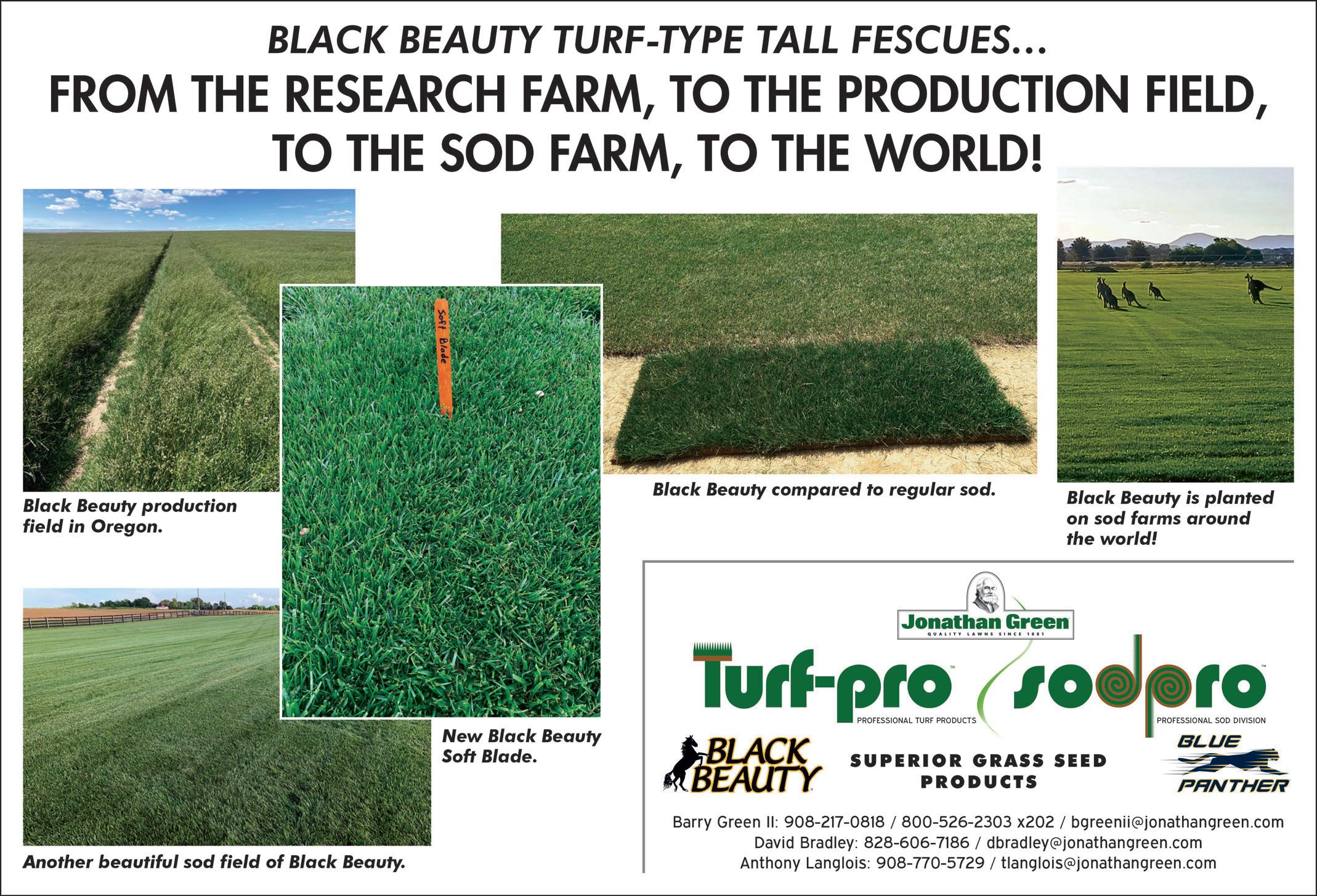
Compiled by Suz Trusty
Governmental decisions—local, county, state, and national—have a direct impact on every farm and farmer in the U.S. To better navigate the ocean of laws, rules, and regulations, farmers need allies, entities that understand the issues you are facing, and that are equipped and empowered to express your position to the appropriate governmental decision-makers. Allies are especially important for specialty crop farmers—including those focusing on turfgrass production—who have crop-specific issues and concerns in addition to those involved in producing commodity crops.
The most powerful ally at the state level is the state’s secretary of agriculture. Those individuals combine their efforts to take your message to the national level though the National Association of State Departments of Agriculture (NASDA). NASDA is a nonpartisan, nonprofit association which represents the elected and appointed commissioners, secretaries, and directors of the departments of agriculture in all 50 states and four U.S. territories. NASDA enhances American food and agricultural communities through policy, partnerships, and public engagement. To learn more about NASDA, please visit www.nasda.org.
According to a press release issued on January 22, 2024, NASDA has chosen five issues to serve as the organization’s primary policy focus for 2024. They include labor reform, the 2024 Farm Bill, pesticide regulation, food safety, and PFAS.
NASDA CEO Ted McKinney remarked on the gravity of these issues for 2024. “These issues were chosen for the organization’s 2024 focus as NASDA members see urgent need for action in these areas…” And McKinney noted, “Further, we believe these are the areas where state departments of agriculture are uniquely positioned to champion policy solutions this year.”
The NASDA press release included brief statements addressing each of the focus areas and reported it has published one-page documents offering background and insight for each policy priority that are available at NASDA.org/policy, along with further information on all of NASDA’s policy work.
Because the focus of this issue of Turf News is “Tackling Labor Issues,” the copy from NASDA’s one-page paper on labor, titled “AGRICULTURAL LABOR REFORM,” follows.
Farmers and ranchers need a legal, reliable workforce that supports their farms and treats workers respectfully. American agriculture faces a critical shortage of labor that harms annual harvests, animal agriculture production, and processing facilities. This damages American competitiveness and overall food security. Both farmers and U.S. consumers have been haunted by labor shortages, which are driving up prices and threatening U.S. agriculture’s place in the global marketplace.
Reforming the H-2A program would provide farmers and ranchers with a legal and reliable workforce while curbing rising food prices and maintaining our global competitiveness.
By 2026, nearly 25 percent of the U.S. workforce will be 55 and older, according to the Bureau of Labor Statistics. The agricultural and food sectors comprise more than 21 million full and part-time jobs, which continues to rise annually, according to the USDA Economic Research Service. This means that in less than nine years, more than 5.35 million jobs will be available and necessary to fill in the agricultural and food sectors.
25% of the U.S. Workforce will be 55 and older & 5.53 million jobs will be available in the agriculture and food sector
The H-2A temporary agricultural visa program allows agricultural employers who anticipate a shortage of domestic workers to bring nonimmigrant foreign workers to the United States to perform agricultural labor or services of a temporary or seasonal nature. The H-2B temporary non-agricultural program permits employers who meet the program requirements to hire nonimmigrant workers to temporarily come to the U.S. and perform non-agricultural services or labor based on the employer’s temporary need.
Due to the ongoing instability in the domestic workforce, the use of seasonal nonimmigrant programs has become vital to ensuring businesses have an adequate supply of labor. The H-2A program has expanded significantly in recent years. Similarly, applications for the H-2B program have well exceeded its statutory cap of 66,000 visas. In the H-2A program, the Department of Labor reports more than 302,000 certified positions for H-2A workers through the 3rd quarter of fiscal year 2023. Throughout the entire fiscal year of 2020, there were only 275,430 certifications.
NASDA supports border control and border security measures in conjunction with meaningful congressional reform as a means toward a legal and stable workforce. NASDA believes both the current H-2A visa for temporary agriculture workers and the H-2B visa for temporary non-agricultural workers are impractical and in need of comprehensive reform.
NASDA supports the Farm Workforce Modernization Act, which would reform the H-2A program to provide more flexibility for employers while ensuring critical protections for workers. It would also establish a program for agricultural workers in the United States to choose to earn legal status through continued agricultural employment and contribution to the U.S. agricultural economy. Finally, the bill focuses on modifications to make the program more responsive and user friendly for employers and provides access to the program for industries with year-round labor needs.
NASDA Comments on the Department of Labor’s proposed rule for temporary agricultural employment
•NASDA outlined concerns that the DOL’s proposed rule seeks to expand labor organizations’ access and input to the H-2A program in an inefficient manner and potentially undermining the program’s goals. NASDA Comments on Department of Homeland Security proposed rulemaking on modernizing H-2A Program.
•NASDA is interested in the department’s provision in this proposed rule that would clarify that H-2 workers may take steps toward becoming lawful permanent residents of the United States while still maintaining lawful nonimmigrant status. NASDA also seeks an “at-will” visa where employees do not have contractual commitments and can move between employers as seasons and labor demands change.
As Congress considers immigration legislation, NASDA recommends the following criteria:
•Amend the H-2A and H-2B programs to include year-round workers for agricultural, livestock, and forestry industries.
•Respect and recognize the importance of our current experienced but unauthorized workforce by creating a mechanism for workers in good standing to earn legal status based on agricultural work experience.
•Ensure flexibility by allowing guest workers to access and work in all types of agriculture, not just those occupations limited to seasonality.
•Establish a market-based approach to wages that is fair to both the agricultural employee and employer.
•Provide the ability for agricultural employers to meet expanding labor needs without arbitrary limits.
While not included in their top five focus areas for 2024, NASDA offers ongoing support for growing the labor market within the U.S. in the following areas.
Connections to STEM Careers: NASDA supports the expansion of school-based agricultural education curricula that aligns with the Agricultural, Food and Natural Resource content standards.
Work Based Training and Certifications: NASDA encourages the U.S. Departments of Labor and Education to work with NASDA and the agriculture industry at large to expand work-based training, including apprenticeships and micro credentials that address skilled and unskilled labor shortages.
Agency Collaboration: NASDA encourages the U.S. Departments of Agriculture, Labor, and Education to collaborate by creating standards, platforms, and resources that address workforce needs.
Youth Leadership and Community Development: NASDA supports growth in community and youth development that encourages awareness and understanding of the agriculture, food, and natural resources industries and their potential career opportunities. Organizations such as 4-H, the National FFA Organization, Minorities in Agriculture, Natural Resources and Related Sciences (MANRRS) and Agriculture Future of America are recognized internationally and provide the U.S. with key strategic advantages relative to other countries in developing tomorrow’s workforce.
In the increasingly complex marketplace with multiple business segments competing for competent and dedicated workers, it is especially important for sod producers, as part of the specialty crop market segment, to cultivate powerful allies at the state, as well as the national, level.
Suz Trusty is co-editor of Turf News. Graphic Credit: NASDA Agricultural Labor Reform Data 2024

Editor’s note: This is the TPI Leadership, Innovation, and Technology (LIT) Committee’s article addressing innovative solutions.
Does every year on the farm seem more stressful than the last? Does it feel like you are always behind, trying to juggle situations that constantly compete for your attention? Do you feel the need to frequently intervene and (sorry for the m-word) “micromanage” all aspects of your operation?
Sod farming is one of those unique types of agriculture that is generally more complicated and more difficult to run efficiently. Harvest season takes up a large portion of the year, or is a year-round constant endeavor. Sod needs to be marketed and sold. Sod’s short shelf life makes it critical that sales, harvesting, and trucking are working efficiently. Many growers are producing several types of sod with different input needs, different pieces of equipment, and with different production schedules.
Almost every aspect of running a sod farm can be broken down into processes, some simple and some more complex. All farms have at least a simple process for taking an order, a process for tilling and planting a new crop, a process for tracking routine maintenance on equipment, and so on. Sometimes these processes are documented in detail, sometimes the process only lives in someone’s mind.
The key to effectively managing your operation may lie in adopting the mindset and culture of continuously documenting, evaluating, and improving the processes that make up your business. When properly documented, these processes become “Standard Operating Procedures” (SOPs) and serve as a backbone of how your company operates across all departments.
Why should we bother documenting something “we all just know how to do?” There are many reasons why well-defined processes benefit any business such as:
• Fewer mistakes and higher quality work
• Training is more thorough and easier
• Standardization and employee accountability
• Allows management to focus on other areas of the business
• Business is more resilient in response to unplanned absences
• Improvement is more rapid, and results can more easily be measured
Documenting the order-taking process is usually the first place to look if you are seeking to reduce costly mistakes. We have all delivered sod to the wrong address, delivered sod on the wrong day, or delivered the wrong product to the wrong address on the wrong day. No matter if you are using paper tickets, a spreadsheet, or ERP (Enterprise Resource Planning) software, you can standardize the order-taking process by clearly listing the necessary information and expectations for the person taking the order. Some ideas to include in the process:
• Create a simple checklist on your order form that ensures key points are on the order such as phone number, delivery address, payment method, etc.
• If the order is taken over the phone, read back the most important points to the customer to help catch any mistakes.
• Manually or automatically text order confirmation and/or invoice to the customer the day prior to delivery with the order address and quantity.
Training new and existing employees is easier and more effective when you have well-documented procedures to help with onboarding. These SOPs will never replace onthe-job training but rather will accompany that training and be a resource for new employees as they become more familiar with their jobs.
Consider Farm A, training a new harvester operator by having them sit in the cab with another operator who is explaining how to cut and what each button does. The operator also explains changes to machine settings and operation based on weather conditions, and also how to open up a new field. Then the operator explains and demonstrates the maintenance that is required to do each day and week. Realistically, this is way too much to remember in even several sittings, so it ends up taking days to weeks to get a new operator running.
Farm B on the other hand, still explains and demonstrates everything that Farm A does but also provides the new operator with a binder of documentation that outlines everything he or she is learning on the job. There may be a copy of the manual, a page with helpful tips, a page with what to do when the ground is wet vs dry, how to open up a new cutting edge, and a daily and weekly maintenance checklist. Training an employee this way is undeniably quicker and it
is more thorough, since the documentation may catch items that the existing operator missed or could not adequately demonstrate, such as current weather conditions.
Having everyone consistently perform the same general actions is also extremely important to the quality of your operations. One example of this would be standardizing even something as simple as a sod delivery (customize this to your operation):
• Arrive at Customer Location/Jobsite.
• Read the delivery ticket for placement notes. If no notes, call the phone number or ring the doorbell.
• Check to ensure that the order is paid. Contact the office if it is not.
• Unload sod.
• Attach packing slip/sod certification to pallets.
• Obtain signature (and/or take a picture of sod at the jobsite) for delivery verification.
• If the customer is not on site, text the customer that the sod was delivered.
• Attach piggyback, safety pins, and pigtail.
Setting a standard policy will make it clear to drivers what the expectations are. Sometimes deviations will have to be made, and these can even be built into the procedure. The alternative is having a verbal policy that leaves too much room for interpretation and forgetfulness.
Employees, management, and ownership will have clear expectations for one another and will be able to see more clearly who is thoroughly completing their duties. Now the duties are properly defined in detail, versus vague “job description” type responsibilities that leave room for a high amount of interpretation. This leads to increased accountability for your employees and management, and your team will perform higher quality work since expectations are clear.
A good example of this is the airline industry. Even though almost all pilots could recite and successfully complete their pre-flight checklist items from memory, they are still required to go through the checklist, because even seasoned pilots would otherwise occasionally make mistakes, with severe consequences.
Employees, management, and ownership will have clear expectations for one another and will be able to see more clearly who is thoroughly completing their duties.
Another key aspect of standardization is reporting. Certain key processes should have some way of reporting how well that process is working. Examples could be:
• Order defect rate (sales/fulfillment process)—How many orders have an error that affects customer satisfaction?
• Field waste (production)—How many square feet are harvested from a given field?
• Driver efficiency (delivery)—How many miles (kilometers) are driven and how many square feet (square meters) of sod does each driver deliver per hour of work?
Many operations have issues where owners and management need to get involved frequently in the hourto-hour and day-to-day operations. Proper management is of course vital to the success of the business, but many times management will become too involved in the basic business processes and therefore lose sight of the broader business picture. If people throw around the “micromanagement” word in your organization, it is likely a symptom of poorly documented processes. Processes fail and management steps in reactively, applying a “band-aid” to fix the problem this time, but it inevitably happens again.
A key mark of a competent and valuable manager is their ability to proactively identify and implement permanent solutions to problems.
An example of this is the handling of “sod complaints.” There always seems to be a discretionary gray area in the handling of sod complaints and it seems that every complaint needs to be escalated to a manager or an owner. The truth is that probably only about five percent of complaints actually might benefit from this escalation; the office staff just needs to be given a guide or flowchart of what to do. You can decide how rigid or lenient these can be but here are some ideas:
• Automatically replace sod for Retail Customers (likely purchasing at a higher price) once they submit photos of the affected area and a description of what happened.
• Automatically replace sod under a certain square footage as long as no other replacements have been granted to a customer in the past calendar year.
• Automatically replace sod for wholesale customers as long as total replacements are less than one percent of total sales to that customer.
• Require the customer to acknowledge that replacement sod will be installed in time and watered sufficiently (these two deficiencies seem to be the cause of 99 percent of sod issues).
These types of guidelines would empower your sales and office staff to help the customer immediately, which leads to happier customers and less management intervention. There will always be some unique situations that require management involvement but even partially reducing them will make everyone more productive.
Everyone has probably run into a situation where a key employee has a planned or unplanned extended absence, and other employees are asked to fill in until that employee returns. Imagine how much more difficult this is when that person’s responsibilities are poorly documented and reliant on that key employee just “knowing what to do.”
Best case scenario, even if you have several weeks’ notice, it is difficult to fully document all aspects of certain job descriptions. Worst case, it’s a completely unplanned absence or resignation and you or other employees have to scramble to figure out that person’s job on your own. This is another reason why it makes sense to document and continually improve your business processes when you have the time to do so.
Many business owners have the goal of continuously improving as their business grows and evolves. Even if your current processes are not ideal, you should document them as a starting point to improving them:
•It’s easier to collaborate with other employees when everyone is on the same page. Allowing the office staff to read about harvest procedures may generate good ideas for improvement and vice versa.
•Forcing yourself to write down your ad hoc processes is a good exercise that many times will result in ideas for improvement as you focus on them.
•For more complex processes that involve interaction between multiple departments, it makes it easier to conceptualize changes if the process is outlined with examples. i.e., The process of dispatching an order to be cut and loaded requires interaction between the customer, office, harvesting crew, and drivers.
•It's helpful to see how your processes have changed over time, and retaining records of previous versions allows you to go back and see what changes worked well and what still needs improvement.
Creating a portfolio of these processes over time is an excellent way to dramatically improve your business. It might seem daunting at first, so set yourself up for success by not choosing the most complex processes for your first few. Here are some tips for creating these:
1.Commit to putting all of your SOPs in one location. Do not make the mistake of having some on paper, some on a shared folder, some in a task management system, etc. Pick one master location and keep them all there.
2.The instructions should be both thorough and as simple as possible. Do not overcomplicate instructions by being overly specific. A good rule of thumb is that they should be easy enough for a high school student to understand (not a 7-year-old).
3.Create a standard format to apply to each set of instructions. Include a title, the SOP author, and a revised date at a minimum. It is also helpful to include “why” the SOP exists with a very brief explanation of the process.
4.Commit to reviewing all of these SOPs annually—at a minimum—and evaluate if they are still working well or need attention as the business evolves.
5.Some processes require some human discretion. Do not over-constrain your employees by trying to completely rule out the human factor. There are always extreme exceptions to processes that are best handled by having people make decisions.
6.Do not frequently deviate from procedures once they are put in place. If you find people are deviating from them, it might be worth investigating why. It is possible that the procedure may need to be changed for a good reason.
7.Make this part of your company culture. Ideally, it is your employees (the people who are actually doing the work) who should be writing and modifying these as opposed to exclusively the owners and upper management. Try to involve employees as much as possible in the process of writing these.
While it can take some time to thoroughly cover most aspects of the business, you will likely begin to see the benefits of operating this way almost immediately. Having clearly documented procedures for the field crew, drivers, and office will reduce stress for everyone involved, allow workers to produce better work in less time, and set you up for success as you continue to improve your operations.
Jack Warpinski is the general manager at Central Sod Farms, Inc., based at the company's Centreville, Maryland, location. This article is based on his experience managing the operation for the past 15 years.Jack is a member of the Leadership, Innovation, and Technology Committee. He can be contacted by email at jack@centralsodmd.com.







Compiled by Suz Trusy
It seems 2023 is best described as a roller coaster ride, filled with highs and lows that came one after the other often at dizzying speed—and 2024 started another round on the same path. Along with extreme weather conditions and unpredictable economic interactions, ongoing wars between Russia and Ukraine and Israel and Hamas add to the uncertainty. Plus, the upcoming U.S. presidential primary elections bring even more partisan animosity to the governmental scene. Yet, once again, you persevered through it all. So, looking ahead, this outlook, compiled from multiple agricultural and economic experts’ predictions, highlights many issues that could impact your operations in 2024.
On January 26, 2024, The Hill reported in its Business & Economy e-news posting that, “The U.S. economy defied widespread recession fears and ended 2023 with surprisingly strong growth. During the fourth quarter of 2023, gross domestic product (GDP) grew at an annual rate of 3.3 percent, according to data released Thursday by the Bureau of Economic Analysis (BEA). Growth in the final three months of the year outstripped the predictions of many economists, who forecasted a 2 percent gain.”
Purdue University Department of Agricultural Economics experts looked to 2024 and provided insights into the national economy, trade, policy, and food prices. These findings were recently published in the Purdue Agricultural Economics Report’s annual outlook, including potential outcomes of a delayed farm bill. “As we enter 2024, the complexities surrounding the farm bill debate persist. With federal spending cuts in focus, the projected cost of the farm bill will likely take center stage in agricultural committee deliberations this year,” said Roman Keeney, associate professor of agricultural economics at Purdue University and co-editor of the report. “The Purdue Agricultural Economics Report will closely monitor the evolving farm bill situation through its policy brief series, offering insights into critical legislation impacting farmers nationwide.”
Inside the issue, Purdue agricultural economists predict an overall positive outlook for 2024 with modest GDP growth, low unemployment, decreasing inflation, and a potential lowering of interest rates. “The Federal Reserve increased their policy rate at the end of 2023 but has kept it stable since August. Recession is a possibility, but it would be sheer stubbornness to continue predicting recession in the face of so much good news,” said Larry DeBoer, professor emeritus of agricultural economics. “My guess: There is no recession in 2024.” To read the full Purdue Agricultural Economics Report, visit https://purdue.ag/paer.
The latest edition of America's Farms and Ranches at a Glance: 2023, which offers a comprehensive overview of U.S. farm and ranch characteristics, was released in December 2023. The complete report can be viewed by going to the website: https://www.ers.usda.gov and type America’s Farms and Ranches at a Glance: 2023 in the Search bar.
American farms represent a diverse set of business operations and farm operators. This annual report describes the characteristics of U.S. farms and ranches using the most recent data from the Agricultural Resource Management Survey (ARMS). Statistics are presented using a farm classification developed by USDA, ERS (Economic Research Service) to categorize farms into groups with some common characteristics. The classifications used are mainly based on each farm’s annual revenue, the main occupation of the farm’s principal operator, and ownership (family versus nonfamily). This edition of the report also provides information on the usage of credit by lender type and farm size.

Following are a few of the “Conclusions and Implications” included in the report. U.S. farming is still overwhelmingly a family business. In 2022, 97 percent of U.S. farms were family farms, accounting for 90 percent of farm production. Small family farms made up 88 percent of the farm count and operated 46 percent of the farmland but generated only 19 percent of the total value of production, as shown in Figure 1. The largest share of the value of farm production (52 percent) occurred on large-scale family farms. The share of farms with a low-risk operating profit margin (OPM) varied by farm size in 2022. Between 52 and 79 percent of small family farms had an OPM in the high-risk zone (OPM less than 10 percent), depending on the farm
type, compared with 37 and 27 percent of midsize and large family farms, respectively. Some small family farms of each type operated in the low-risk zone, as did more than 39 percent of midsize and large-scale family farms. About 26 percent of all U.S. farms held any debt in 2022, and the majority (67 percent) of farms with debt used one lender. Over half of these farms reported loans owed to a commercial bank, compared to 8 to 10 percent with loans serviced by USDA, Farm Service Agency, and 31 to 43 percent with loans serviced by the Farm Credit System, depending on farm type, in 2022.
As Tyne Morgan reported on December 22, 2023, in a posting on https://www.thedailyscoop.com/, “From the election to world trade, as well as geopolitical factors that have the potential to shape agriculture in 2024, ag economists think the coming year is poised for several possible surprises that could have a direct impact on farmers across the U.S.” The December Ag Economists’ Monthly Monitor, a survey conducted by the University of Missouri and Farm Journal, shows economists' views on the ag economy are slightly more positive compared with the past month. While expectations about 2024 net farm income remained steady, ag economists' outlook for the year ahead grew slightly more pessimistic. Nearly 70 ag economists are invited to participate in the survey each month.
The survey asked, “What unexpected news headline would you not be surprised to read in 2024?” A few that the economists suggested follow:
•China falls into big recession.
•A second extension of the farm bill.
•End to Russia/Ukraine war bumps global food grain supplies and cuts prices.
•Economic woes unfold for U.S. agriculture as input costs remain high and farm prices falter.
When asked what they are most concerned about when it comes to the ag economy, the following are among their top concerns.
•Geopolitical factors, including war and disruption, global competition, and other potential disruptions.
•Domestic politics, including the 2024 election and policy detrimental to biofuels use, and government debt leading to rising interest rates and finance costs.
•Decline in commodity prices paired with increasing input and land costs, leading to squeeze in margins.
The survey also asked the Ag economists what they’re most optimistic about when it comes to the ag economy for 2024. Some of their top choices follow.
•Demand opportunities through domestic soybean crushing, renewable fuel, SAF and global oilseed.
•Robust domestic consumption and opportunity for competitive pricing of U.S. commodities in global markets.
•Improved farm-level conditions related to efficiency, moisture conditions, and farm income above historical averages (if a recession is avoided and input costs come down); many ag producers still have a strong balance sheet.
A January 2024 press release issued by Farmers National Company reported that despite increasing pressure from declining commodity markets, rising interest rates, and inflation, the land market seems to be moving into 2024 maintaining the value increases it has built during the past three years. The sharp increase in land values from a year ago that was primarily driven by strong commodity markets has slowed, but those values are being maintained, as evidenced by the company’s sales results in the past six months. Buyer demand remains strong for good quality cropland across the Midwest, while the supply of land for sale remains limited.
Moving into 2024, many landowners are deciding to take advantage of the current land value strength and sell into a market with a large pool of motivated buyers. At the same time, other landowners have contemplated the current appreciated value of their land assets and determined there is no better investment outside of land. These landowners are deciding to retain ownership and further limit the available properties coming into the market.
Following the Ag economic fluctuations provides insight into multiple aspects of your business. Here’s a newly developed tool you can use to do so. The Pilot (testing) program for the Farmers.Gov/Dashboard was introduced by Farmers.Gov on January 18, 2023, as “A Gateway into Farmer-Focused Data and Information.” While USDA provides many farmer-focused data sets and local resources, these often are spread across numerous online sources which may be tough to find or easily analyze. The Farmers.Gov dashboard is a single site to easily access your local state and/or county-specific agriculture-related data and information from USDA and other government agencies. The Pilot program was only available in Iowa. It has now been expanded to many additional states, with the remainder to be added soon. No login is required. Just go to the website (https://Farmers.Gov/Dashboard) and select your state and county to view the resources for your location.
Suz




Have you seen one of our service trucks in your area?
Our expanding fleet of Magnum Service Trucks is equipped with all the necessary parts to repair your Magnum Equipment. Our skilled Technicians are traveling nationwide, making farm visits in your area. Let us know if you’d like to be added to our service schedule. Experience the convenience of having a big red Magnum Service Truck arrive at your farm, ensuring your equipment operates at its best. Contact us today for a Technician visit, and your equipment will thank you for the improved performance!









Early-life exposure to green space is important for children’s bone health during crucial periods of growth and development. This fact is stated in JAMA Network Open, the Journal of the American Medical Association. It’s based on the study “Exposure to Residential Green Space and Bone Mineral Density in Young Children,” which appeared in an open-access report published on January 4, 2024. JAMA listed the importance of the study as “Bone mass accrual is influenced by environmental and lifestyle factors. Targeted interventions at the early stages of life might decrease fracture and/or osteoporosis risk later in life.”
Background and Study Goal
The report stated that bone mass, a composite of bone size and mineral density, is a key determinant of bone strength throughout life. Peak bone mass is achieved in early adulthood and depends on the bone mass accrual during skeletal growth and development. For this reason, suboptimal accrual at a young age is as crucial to the onset of osteoporosis as bone loss through aging. Hence, targeted interventions on bone mass accrual at the early stages of life may decrease fracture and/or osteoporosis risk later in life. In addition to genetic factors, early-life physiologic, lifestyle (e.g. nutrition and physical activity), and environmental factors may also play an important role in bone mass accrual.
Several studies have reported the benefits of early-life green space exposure on neurocognitive and social behavioral developments, as well as on the mental and emotional wellbeing of children. Moreover, higher green space exposure during childhood has also been associated with lower body mass index, reduced risk of overweight or obesity, lower blood pressure, and higher physical activity. Despite increasing evidence about the health benefits of green space exposure, the available studies on the association with bone mineral density are scarce. One large population-based, epidemiologic study, reported that living in a greener area was associated with higher bone strength in adults, suggesting that residential exposure to greenness may positively influence bone health. In this context, the aim of this study was to investigate the association between earlylife exposure to residential surrounding green space and bone mineral density in children aged 4 to 6 years living in an affluent society.
As reported in the document, this study is part of the ongoing prospective Belgian birth cohort ENVIRONAGE (Environmental Influence on Aging in Early Life), in which mother-newborn pairs were recruited at the time of delivery. At four to six years after birth, mother-child

pairs were contacted and invited to participate in a followup examination. A total of 55.7 percent of the initial participants took part in that examination with radial bone mineral density assessed in 327 children.
A semi-structured questionnaire containing questions on sociodemographic, lifestyle, and health information of the mother and child was completed during the follow-up visit. Precise details on the types of data gathered are included in the document, ranging from the children’s ethnicity to daily screen time, dairy product consumption, and body mass index. Due to the ages of the children, quantitative ultrasonography, a radiation-free technique, was used to assess bone mineral density.
The children’s addresses were geocoded and green space information for those areas was obtained based on the highresolution land cover data in the Green Map of Flanders. The percentage of green space was calculated by vegetation height greater than 3 meters, vegetation height less than 3 meters, and total green space, within several radii (100, 300, 500, 1,000, and 5,000 meters). Statistical analysis of all collected data was conducted between January and February 2022. Details were provided on both the processes used and the probability factors investigated.
The evidence this study provides about the importance of residential green space on bone health from birth until 4 to 6 years has public health relevance. It highlights the urgent need to raise awareness among policymakers of the importance of conserving and expanding residential green spaces. The promotion of such preventive strategies might decrease fracture and/or osteoporosis risk later in life, resulting in financial, physical, and psychological benefits for the individual and the community.

The TurfMutt Foundation reported in a January 2024 blog post (www.turfmutt.com), “According to a new report, access to the outdoors—including our own backyards and community parks—reduces poor health in older adults. To compile the report, scientists examined health survey data from more than 42,000 Washington [state] residents over the age of 65. The data was then measured against the respondents’ access to green and blue spaces.”
That report defined “blue space” this way. “The field of built environment research now recognizes blue space—a term referring to all visible surface water in the environment such as ponds, streams, lakes, and rivers—as a natural part of the landscape with a potential impact on human health. The beneficial effect of the availability of blue space on mental and physical health is seen among certain populations, and a recent study suggests positive associations between reduced distance to blue space and improved mental health.”
That report also noted, “Although one in five American adults over the age of 55 experience some type of mental health problem, such as depression, anxiety, and mood disorders, mental health conditions are widely underdiagnosed and undertreated among older adults.” And, “Despite the burden of poor mental health in the nation, about a third of adults with serious mental health illness did not receive any mental health services, and nearly half of the adults with serious mental illness perceived an unmet need for mental health services.”
In addition, according to the report, “The effects of mental health disease in the U.S. population have far-reaching implications. Older individuals with depression are at a higher risk for dementia, cardiovascular disease, and delayed or poor recovery from physical illness, suicide, and death.” And added, “Given that population trends indicate a rapidly expanding population of older adults, the importance of mental health in this vulnerable population is quickly becoming a topic of great concern.”
The TurfMutt blog further reported, “The scientists found that about two percent of participants showed signs of psychological distress and 19 percent reported having only fair to poor general health. But the respondents who had just ten percent more green space close to their homes reported better health.”
The report found that, “In addition to green space availability, reduced distance to green space has been associated with better mental and physical health.

Decreased distance to usable green space was associated with decreased anxiety or mood disorder treatments, while greater distance from green space was associated with increased behavioral disorders and worse mental health conditions.
The TurfMutt blog added, “Study authors say the research points to the need to look more closely at exposure to nature as a way to improve mental health outcomes in older adults. They note nature prescriptions—written medical orders to spend time outdoors—could be one way to accomplish this.”
The report stated, “Literature regarding the association of the built environment with health outcomes in older adults (defined as adults aged 65 or older) is evolving. Studies in Korea, China, and Australia have shown improvement in self-rated health and mental health among older adults with greater availability of green space. … study findings may facilitate programs to improve neuropsychiatric outcomes of older adults in urban areas, and these results may also provide evidence that protecting green and blue spaces in urban planning initiatives is beneficial for public health.”
The full report issued by ScienceDirect, is available at the link that follows.
Urban green and blue spaces and general and mental health among older adults in Washington state: Analysis of BRFSS data between 2011-2019 - ScienceDirect
Note that the Behavioral Risk Factor Surveillance System (BRFSS) is an annual, ongoing, telephone health survey of noninstitutionalized, civilian adults aged 18 years and over residing in the U.S. It is one of the largest health surveys worldwide with over 400,000 responses collected across the nation each year.
This study highlights just one of the many reasons science has proven that spending time in green space, including our own backyards and neighborhood parks, is good for us.
Suz Trusty is co-editor of Turf News.
g our

The proposed U.S. Sod Checkoff crossed a key milestone in the fall of 2023 when the USDA’s Agricultural Marketing Service (AMS) announced the opening of the 60-day public comment period. If you’ve been to one of the many sod producer meetings at TPI or other industry shows in the last two to three years where the proposed checkoff has been discussed, you have likely heard me talk about this as the next step in the process. So, how did we get here and what do we expect next? Let’s do a quick recap of the process and timeline.
USDA Research and Promotion programs, aka checkoffs, are nothing new to agriculture. They’ve been around in other agricultural industries for almost 60 years. There are currently 22 USDA Research and Promotion Programs that raise approximately $1 billion annually to fund research and promotion of agricultural products. Some are commodity-based industries, but more recently they have been established in specialty crops more similar to ours.
The path to a checkoff is purposefully long. It involves submitting a proposal that includes an industry analysis, justification, objectives, proposed structure, impacts on small businesses, and likely most importantly, industry support. You can see in Table 1 that after meeting with USDA-AMS in 2018 and with the American Farm Bureau in 2019, we drafted a proposal and initially submitted it to USDA in 2021.
Since that time, I have been traveling the U.S. speaking about this idea and getting input from sod producers nationwide. During those discussions, there were a couple of key points that kept coming up around board structure and an in-state model for research and promotion dollars. These suggested changes ultimately were adopted and drafted into the final version of the proposal in December 2022. After that point, USDA-AMS reviewed it, cleared it, and posted it for public comment on October 16, 2023.
The 60-day public comment period is one of the many points in this process where USDA-AMS wants to hear directly from our industry. They encourage and welcome any and all comments, but at the end of the day, the most fundamental things they want to know are:
1) Is there enough awareness and support for this proposal to bring it up for a vote in a nationwide referendum?
2) If there is enough support for a nationwide referendum, are there any key details that need to be changed before that occurs? and
3) How does our industry want our referendum to be conducted?
After all, research and promotion programs are proposed by, written by, voted in-or-out-by, and run by members of the industry, not by USDA-AMS.
So, where does that bring us today? The public comment period was closed on December 15, 2023, with 245 comments from almost 100 sod farms. All of those comments are available for anyone to read publicly at https:// www.regulations.gov/docket/AMS-LP-21-0028 and will remain there in perpetuity. When broken down by industry segment, 65 percent of all comments came from sod farms, 13 percent came from customers of sod farms (sports field managers, landscapers, individuals, etc.), 13 percent came from industry associations representing customers of sod farms (SFMA, GCSAA, NALP, etc.), and 9 percent came from universities with turfgrass research programs.
Of these 245 comments, 92 percent of them were supportive of at least bringing the proposed checkoff up for a vote while 8 percent did not support a vote, and/or suggested changes in how the referendum should occur if it were to move forward to a vote. Many of the comments referenced the need for regional and national research and promotion dollars to educate consumers, to push back against competitive products, and to protect future
Steps Completed
Initial Discussions with USDA-AMS (2017-18)
Met with American Farm Bureau (2019)
Formation Committee (2020)
Draft Proposal to USDA-AMS (2021)
Updated Language to USDA-AMS (2022)
Public Comment Period Opened (Oct 2023)
Public Comment Period Closed (Dec 2023)
Steps Remaining
Results of Public Comment Period (2024)
If Comment Results Positive, proceed to below:
Notification of Voting Period (TBD)
Notification of Voter Registration (TBD)
Voting Period Opens (TBD)
Voting Period Closes (TBD)
Notification of Results (TBD)
generations of sod farmers. Others shared their concerns about the program which primarily included questions around government oversight, and how the referendum should be conducted. It’s difficult to summarize all 245 comments in one article here, but I certainly encourage everyone to log on and read any or all of the comments at the link listed in this article.
The majority of comments came from sod producers, but individuals in the golf, sports field, and landscape industries, along with associations such as GCSAA, SFMA, and NALP who represent them, also logged on to provide public comment. They recognize that their industries depend on our natural grass products, and anything we can do to promote natural grass will also be beneficial to those industries whose jobs depend on natural grass. Andrew Bray of NALP tells USDA “The landscape industry is reliant on access to sod, but more importantly public misconceptions, outdated research and sod alternatives present tremendous challenges to the value of healthy green spaces throughout the U.S. As the primary purchasers of sod, the landscape industry accepts very minor fees associated with the checkoff program to benefit all the verticals within the green industry.”
While traveling recently, I had a sod producer ask me why anyone other than sod producers gets to provide public comments if they don’t get to vote, which of course is a fair question. If you are wondering that, too, the answer is that this type of input is important to USDA because it answers one of their key questions as to whether or not this will burden consumers if producers pass this cost along to them. The answer those industries have presented here is no.
It’s also important to point out that while USDA accepts comments from anyone, comments from sod producers
If Voting Results Positive, proceed to below:
Board Member Nominations (TBD)
Board Formed (TBD)
Checkoff Begins (TBD)
carry the most weight. They want those the most, they value those the most, and they weigh those the most heavily when considering all of the comments submitted during the public comment period. Again, this step in the process is just meant to give USDA-AMS a general sense of awareness and support. It is not a vote. Historically speaking though, there have been checkoffs that have failed at this stage due to lack of support, just as there have been checkoffs that have moved forward to a vote.
So what are the next steps? As of the writing of this article, we are awaiting an announcement from USDA-AMS on the results of the 60-day public comment period. After they have compiled, reviewed, and summarized all of the comments, they will likely provide a recommendation of whether or not there is enough industry support to proceed to the referendum stage. If the answer to that question is no, then it likely all stops here. If the answer to that question is yes, then as you can see in Table 1, there will be future announcements on how to register to vote, when the vote will occur, and how it will occur. If the U.S. Sod Checkoff were to pass in a nationwide referendum of sod producers, it would then move on to the next steps of opening the call for nominations for board seats, forming the board, and then ultimately starting the checkoff.
There are still many steps to go through in this process, and in the meantime, I’ll continue to get out on the road to visit with producers and answer any questions about this important initiative. As always, please feel free to call me at 847-737-1846 or email me at CReynolds@TurfgrassSod.org at any time, and I’ll be happy to visit with you.


Before you start it’s OK to admit you’re unmercifully critical of any “X Steps” advice when it comes to leadership. Undoubtedly, you’ve got an infinite supply of books and programs that identify the 5 characteristics or 10 traits of great leaders or claim to know the 9 steps to effective leadership.
The fact is, leadership is as much art as it is science. You’ve got to take in all this advice and shape your technique, and practice to suit your style, personality, and the ever-changing circumstances and conditions you face. Now that the disclaimer is out of the way, here are 8 Strategies that will help you prepare for your first—or next—leadership position.
Without exception, the best leaders you’ll meet and work with are also terrific followers. Even more important, they understand that “leader” and “follower” are not fixed positions. They’re interchangeable roles. Sometimes a subordinate has more skill, knowledge, experience, or insight in a given situation. Can you step back and follow when necessary?
The practice of being a good follower also means committing yourself to the process of learning. What can you learn from the people around you? Above you? Below you?
Expanding on the importance of learning––do you have a mentor? If not––get one. Now.
Do you see a theme developing here? One of the greatest treasures taught by a Sensei is this important lesson: “Perfection is not a destination. It’s a never-ending process.”
Mastery is not just a level of achievement. It’s a perpetual commitment to the process of learning, growth, and development. Start now––and never stop.
This one can trigger a great deal of debate. You certainly don’t want to step on toes or show disrespect to those who have more experience. However, the greater problem today is that too many people simply say, “Not my job.” Or worse, “They don’t pay me enough to…”
If you see something that needs doing––do it! And if you’re not sure if you’re staying in bounds––ask if you can have a shot at it.
Long ago Pliny the Elder said, “The only certainty is uncertainty.” Life is change. Our lives, our society, and our business environment are changing at an unprecedented and ever-accelerating rate. No honest leader can tell you with certainty what’s going to happen tomorrow.
One thing that never changes, however, is that the greatest opportunities come from the greatest uncertainty. Learn to be flexible, adaptable, and comfortable with uncertainty and you’ll be much better positioned to seize these opportunities where others run for cover.
If you don’t get the joke, you’ve got serious work to do.
“Perfection is not a destination. It’s a never-ending process.”
You’ve got to simplify complex ideas and problems. You’ve got to express your mission clearly and help people understand decisions and strategies. Most of all, you’ve got to inspire people and unite them behind a strong and meaningful vision.
To do this, you must practice your communication skills––and stay up-to-date on new methods to deliver your message effectively.
It’s tempting and sometimes understandable to grab the short money. As with any investment, those who are willing to sacrifice immediate gratification usually enjoy exponential long-term rewards.
An opportunity to accept more leadership responsibility or meaningful leadership experience will pay much higher dividends over time.
It’s often challenging to summarize leadership as succinctly as possible. Here it is…
“Leadership is sharing. A leader shares.”
The rest of the conversation is about exactly what leaders should share and how. And that can be a lengthy conversation!
This is one of the most important conversations you’ll have as a new/promoted leader. The discussion centers on the fact your success as a leader is ultimately measured by one thing––and one thing only: The success of the people you serve.
What’s talked about here is “power”––your ability to get things done. Power only expands through sharing. You simply cannot do it alone––as much as some might try. If you want to do more––to be more powerful––make others powerful.
As a leader, you get things done when you inspire, empower, and guide others. When they succeed, you succeed. And any failure is ultimately your failure as a leader.
No matter where you are in your leadership journey, the time to start practicing these strategies is right now. The more sincerely you embrace these strategies, the more likely it is that you’ll be noticed by the people who can offer you your next leadership opportunity.
Remember Strategy #4. Act before you’re asked.
What’s stopping you?
Jim Bouchard is an internationally recognized speaker, Leadership Activist, and founder of The SENSEI LEADER Movement™. He’s the author of eight leadership books, and hosts Walking The Walk, a podcast highlighting compassionate, engaged leaders from all areas of business, diverse cultures, and experiences. Jim's programs are an inspirational and interactive exploration into the importance of human-centric leadership. To bring Jim to your organization or event, visit www.ArmstrongSpeakers.com.


In a society where we spend most of our time inside or engaged in sedentary activities, regular exposure to green spaces has never been more important. Our green spaces provide direct access to the benefits of nature, improve the quality of our surrounding environment, and maintain the health and enjoyment of our communities. Millions of acres of lawns bring the benefits of natural grass to life, providing a soft landing for kids at play, an expanse for families to picnic, and a cushion for bare feet to roam. And those are just a few of many benefits natural grass brings to the U.S. and to the world.
So, we are pleased to report Turfgrass Producers International (TPI) and The Lawn Institute (TLI) will again partner with other leading industry organizations in the “April is… National Lawn Care Month” promotion. The purpose of the campaign is to build awareness of proper lawn care, educate the public on the positive social and environmental benefits of natural grass, and support landscape companies, turfgrass producers, educators, green industry companies, and other professionals who want to educate their clients about their lawns.
The promotion, originally introduced by the National Association of Landscape Professionals (NALP), has drawn additional partners along with TPI and TLI: the Outdoor Power Equipment Institute (OPEI); the Irrigation Association (IA), and Voices for Healthy Green Spaces (VHGS), a digital advocacy program launched by NALP in 2022. Partnering in this promotion expands the outreach as each association and its members share the message. This united industry front will help us educate more consumers about the benefits of natural grass lawns.
While the lawn care and landscape industry in the U.S.A. has recognized April as National Lawn Care Month for many years, TPI and TLI are working to spread the word internationally as well as nationally. It’s the start of the spring season in the Northern Hemisphere and the
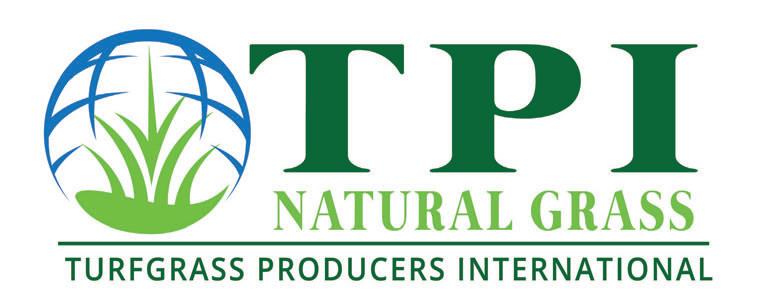


beginning of autumn in the Southern Hemisphere, both seasons when the natural green grass of the lawn is an inviting spot for family activities or entertaining friends. Thus, across the world wherever turfgrass is growing, April is an opportune time to harness the public’s excitement about the outdoors and remind them about the benefits of a well-cared-for lawn.
Prompted by the enforced restrictions of the coronavirus pandemic during 2020, many people around the world discovered—or rediscovered—the simple pleasures their home lawns and public green spaces can provide. That positive momentum extended through all of 2021, 2022, and 2023. Industry research and surveys are reporting it will remain strong throughout 2024. Thus our target audience is even more open to the message of the benefits of natural grass.
So, capture some of that magic by tailoring your messages to the public’s perspective by tapping into the many resources this partnership offers to you—all free of charge!
TPI member are well aware of the many marketing resources available on the website, www.TurfgrassSod. org, including the “Keep It Real” logo. And, The Lawn Institute’s website, https://www.TheLawnInstitute.org, provides links to facts, resources, infographics, and photos


Yards play a vital role in the health of our environment. But did you know that when you take care of your lawn, it takes care of you as well? All managed landscapes, including lawns, gardens and public parks, provide a host of health benefits!
People who live within a half mile of green space were found to have a lower incidence of 15 diseases — including heart disease, diabetes, asthma, migraines, depression and anxiety.1
Physicians are now prescribing time outdoors for some patients, according to recent reports.7 Living in a greener neighborhood could help you live longer.8
Children in green urban spaces are likely to perform better academically. 2 And children gain attention and working memory benefits when they are exposed to greenery. 3
Walking or running in green spaces led to decreased anger, fatigue and feelings of depression.6
Greening of vacant urban areas reduced feelings of depression by 41.5%. 5
For more information about the vital role our living landscapes play in the health of our environment, our communities, and our families, visit savelivinglandscapes.com
A turf area 50’ x 50’ produces enough oxygen to meet the daily needs of a family of four.4
Source: http://www.nature.com/articles/srep11610 Study: University College London Institute of Education, http s://www.childinthecity.org/2018/09/27/children-in-green-urban-spa ces-perform-better-academically/?utm_source=newsletter&utm_ medium=email&utm_campaign=Newsletter%20week%202018-40 3 Article: The Washington Post, https://www.washingtonpost.com/new s/energy-environment/wp/2015/06/15/why-green-spaces-are-good-f or-your-kids-brain/?noredirect=on&postshare=37514 34485282465&utm_term=.4651a0c38a1c
Source: The Lawn Institute, http://www.scienturficsod.c om/growing-great-lawns/lawns-and-the-air-that-we-breathe/ 5 Study: University of Pennsylvania, Rutgers University, Northern Research Station, Forest Service, US Department of Agriculture: https://jamanetwork.com/journals/jamanetworkopen/fullarticle/2688343 6 Source: BMC Public Health, http://www.biomedcentral.com/1471-2458/10/456 Source: Public Radio International, https://www.pri.org/stories/2017-12-30/ getting-outside-prescription-better-health
Source: University of New Brunswick, https://www.thelancet.com/journals/lanplh/article/PIIS2542-5196(17)30118-3/fulltext


Backyarding Has a Purpose. What’s Yours?
Identify your backyard’s purpose, then build the yard of your dreams.









that you can use, like those featured in this article. Or consider using something from this statement developed by TLI. “Picnics, star gazing, and walking barefoot in the grass. Throughout many of life’s moments, lawns have been in the backdrop almost unnoticed, yet an essential element to each instance. They produce fresh oxygen for the air we breathe and cool the environment around our homes and urban centers. They provide a vital habitat for insects, plants, and the birds that feed on them, as well as protection from soil erosion and filtering of urban pollutants. Beyond the environmental benefits, lawns offer a safe place for our kids to play and entire families to enjoy, offering a source of pride and value for homeowners.”
NALP’s VHGS fosters an online community of industry professionals and consumer advocates dedicated to highlighting the beneficial work of the lawn and landscape profession in strengthening local communities, supporting a strong economy, and improving local environments. It also provides the public and decision-makers access to accurate information about key industry issues. For example, the Green Spaces Grow Local Economies graphic, included in this article, ties into the following facts. “Did you know that the landscape industry employs nearly 1.5 million people in the U.S.? Through valuable local partnerships with schools and organizations, the industry helps develop the next generation of workers and drive economic growth.” The many graphics offered on the Voices for Healthy Green Spaces website are free to use on social media to help promote the benefits of green spaces.


OPEI’s TurfMutt Foundation is an environmental education and stewardship program that encourages outdoor living and caring for green spaces. They have chosen “Backyarding” as the name for the pandemicprompted trend of moving indoor activities outdoors. Homeowners improved their backyards to make them an extension of their homes so they could work, cook, exercise, and even vacation outdoors—and they loved it. Promote that trend with the resources—including the two full-page infographics included in this article—available on the TurfMutt Foundation website, https://www.TurfMutt.com. For the southern hemisphere folks, TurfMutt also provides infographics specifically for the Fall season, as well as many that could be used any time of the year.
Marketing via social media provides a great opportunity to tailor your message to your target audience. So, as you develop your 2024 April is… National Lawn Care Month social media outreach, incorporate these resources to encourage your customers and potential customers to enjoy the many benefits of natural grass. Check out the suggestions for doing so on the following page.
Here are a few suggestions to get you started. Promote National Lawn Care Month on your website, in e-newsletters, and/or e-blasts to clients. Add a link to the TLI website which shares facts, statistics, and lawn care tips with homeowners.
Share the story with your local print and broadcast media. Offer to write an article or be interviewed by print media and provide the April is… National Lawn Care Month logo and infographics and be sure to include your company’s contact information. If you keep project before and after photos, offer to share those as well.
Contact your local television community news personnel and talk radio station hosts and offer to be interviewed and/or to share information to help them develop their own story.
Join the social media campaign on X using the hashtag #LawnCareMonth and add the hashtags #NaturalGrass #KeepItREAL! And #TPITurfTalk. Write copy using the facts and resources on the TLI webpage. Here are a few samples:
•Did you know that a 50-foot by 50-foot lawn provides enough oxygen for a family of 4? #LawnCareMonth #NaturalGrass #KeepItREAL! #TPITurfTalk and #TLIhealthylawns
•Spring has arrived. Here are some tips to help care for your yard. #LawnCareMonth #NaturalGrass #KeepItREAL! #TPITurfTalk and #TLIhealthylawns
•Fall has arrived. Here are some tips to care for your yard. #LawnCareMonth #NaturalGrass #KeepItREAL! #TPITurfTalk and #TLIhealthylawns
•Did you know lawn games have been around since the 17th Century? #LawnCareMonth #NaturalGrass #KeepItREAL! #TPITurfTalk and #TLIhealthylawns
Other Great Facts to Share
•Lawns trap more than 12 million tons of dust and dirt annually. (The Lawn Institute)
•Turfgrass, like that found in our lawns, is much cooler than asphalt or cement, acting as an “air conditioner” for the surrounding area (lawns can be 22 degrees cooler than urban asphalt "heat islands").
•Healthy turfgrass has many miles of fibrous roots that hold soil and filter rainwater. (National Arboretum Grass Roots Project). A single grass plant can have more than 300 miles of roots.

Share on Instagram, posting photos of your lawn projects (or those of your clients if your company does not do sod installations) using the tags #LawnCareMonth #NaturalGrass #KeepItREAL! #TPITurfTalk and #TLIhealthylawns.
Blog about it! Use the logo and photos to add interest. Introduce a new topic several times throughout the month, sharing lawn care tips, the environmental benefits of natural grass and infographics.
Post the facts and resources on your Facebook page. Include photos of beautiful lawns and—even better—of people enjoying their lawns. Keep the message fresh with frequent new posts and invite your Facebook friends to share your posts with their friends.
Can you imagine the impact if the good news about natural grass goes viral?


Van Vuuren has been the leading supplier of machinery for the turf industry since 1988.
Van Vuuren has been the leading supplier of machinery for the turf industry since 1988.
growers optimal results under any circumstance. Sod Harvesters
growers optimal results under any circumstance. Sod Harvesters






•40 or 48” Big Rolls
•
•Cutting speed approx. 40m/minute




•16, 18, 23 or 24” Rolls
•3 or 5 gripper
•All palletsizes possible

•Now up to 2000 m2 per hour!



•16, 18 or 24” Rolls or Slabs
•Ergonomic hand stacked
•Up to 1000 m2 per hour




•16, 21, 23 or 24” Rolls
•A single cutting head (43”), double cutting head (2 x 21, 23 or 24”) or three
•Up to 3600 m2 per hour

www.vuuren.comsales@vuuren.com+31(0)30
www.vuuren.comsales@vuuren.com+31(0)30
666 1348
666 1348

Turfgrass is often viewed incorrectly as having a negative environmental impact, but in the case of sod production, harvesting may actually prove to be helpful in protecting the environment. Back in 2009, sod farms within the Lake Okeechobee watershed in South Florida were surveyed to determine their production and fertilizer practices, and to ultimately determine the nitrogen (N) and phosphorous (P) impacts for the watershed (Figure 1). Ten sod farms participated in the in-person survey, to answer various questions about turfgrass species, acreage, harvest cycles, fertilizer sources, fertilizer use rates and application timings, and more. Nutrient pollution from agricultural crop production is a concern in the Everglades Agricultural Area of south Florida, therefore, the overall goal of this study was to examine sod farms and their particular utilization of N and P.

Results from the survey revealed that bahiagrass (Paspalum notatum) was grown on the greatest area at 13,500 acres (5,463 ha), followed by St. Augustinegrass (Stenotaphrum secundatum) at 9,208 acres (3,726 ha), bermudagrass (Cynodon dactylon × C. transvaalensis) at 465 acres (188 ha), and zoysiagrass (Zoysia japonica) at 299 acres (121 ha) (Figure 2). Approximately 86 percent of a harvested acre (1 acre = 0.405 ha) was transported from the sod farm for bermudagrass, St. Augustinegrass, and zoysiagrass, and
65 percent for bahiagrass, with the remainder used for regeneration. The survey also revealed sod growing sites were composed of either sand-based soil or “muck” (i.e., organic) soil (Figure 3).


For all sod farms, sod cut thickness (i.e., soil depth removed with harvested sod) was one inch (2.54 cm). Growing and harvest cycle duration varied by turfgrass species. Bermudagrass was capable of producing two
harvests per year for a six-month production cycle. St. Augustinegrass and zoysiagrass production depended on market demand but was typically one harvest per year over a 12-month growing cycle. Bahaiagrass was grown for three to four years before being harvested for sod on a 10. 5 month growing cycle. The actual land area of bahiagrass harvested each year was less than St. Augustinegrass, even though more land was used for growing bahiagrass.
The predominate nitrogen (N) source used was ammonium sulfate (21N-0P2O5-0K2O), and diammonium phosphate was the most commonly utilized phosphorous (P) source. Other fertilizer sources were applied (i.e., ammonium nitrate, monoammonium phosphate, sulfur-coated urea, sewage sludge, and more). Of note, all farms followed guidelines for best management practices using fertilizer recommendations published by Florida’s Department of Agriculture and Consumer Services.
Sod samples were randomly collected for each turfgrass species grown on each sod farm (20 sod production fields total: two bahiagrass sites, three bermudagrass sites, eight St. Augustinegrass sites, and six zoysiagrass sites). Soil samples were extracted from each sod section. All soil samples at the one-inch (2.5 cm) depth were oven-dried and then processed for laboratory analysis at the University of Florida’s Belle Glade Research and Education Center (Belle Blade, FL). Total N was determined by adding total Kjedahl N plus nitrate plus nitrite, and total P was determined by digesting the sample to measure actual P. All N and P data means were calculated from five replications as a completely randomized experimental design.
For those 20 sod production fields among those 10 sod farms participating in the survey, N and P additions (i.e., from fertilizer applications) and exports (i.e., from harvested sod) were calculated from the survey and laboratory data analysis (Figure 4). The total N applied through fertilizer was 2,711 lb N (1,230 kg N). Total N removed in the soil from harvested sod was 5,104 lb N (2,315 kg N). Thus, the total N exported (or removed from the watershed, greater than the amount of N applied) was 2,393 lb N (1,086 kg N). The total P applied through fertilizer was 818 lb P (371 kg P). Total P removed in the soil from harvested sod was 1,347 lb P (611 kg P). Thus, the total P exported (or removed from the watershed, greater than the amount of P applied) was 529 lb P (230 kg P). Overall, laboratory analysis and calculations from those results indicated that 90 percent of sod farms had net exports of N and 100 percent of sod farms had net export of P. Thus, sod production provides a route for removing these two nutrients from this fragile hydrologically-linked ecosystem.

Figure 4.
removed from the watershed geographic area).
This study documented fertilizer inputs on sod farms in Florida’s Lake Okeechobee watershed and specifically N and P removal from sod harvesting. Therefore, reducing N and P fertilizer inputs and increasing the removal of those nutrients through sod harvests, could have an ultimate net positive effect of lessening the nutrient load into Lake Okeechobee and subsequent discharges into hydrologically-linked ecosystems such as coastal waters and the Everglades. In conclusion, reductions in fertilizer inputs and increased N and P exports from potentially fragile environments support sod farming’s contribution to natural resource conservation, environmental stewardship, and sustainable land management practices.
Source: McMillan, M., J. Cisar*, P. McGroary, G. Snyder, and M. Fidanza. 2023. Nutrient evaluation for sod production within the Lake Okeechobee Watershed. Journal of Environmental Horticulture 41(3):101-108.
*Dr. John Cisar (CisarTurfDoc@gmail.com), is an international turfgrass industry advisor and consultant located in South Florida, USA.
Mike

Dealing with troubling workplace environments can be difficult. It’s not always clear what the deeper issue is and the friction and conflict it breeds can be tough to reverse.
At the heart of any organization are its people. Without a dedicated, aligned, and fully engaged workforce, no progress can be made. High-performance organizations excel in creating an environment that recognizes and addresses the fundamental human needs that drive their members.
Psychologist Abraham Maslow's hierarchy of needs, once revolutionary, is now widely embraced and frequently applied to organizational psychology. Leveraging this framework to identify what individuals require for success and taking the necessary actions to fulfill these needs can support the cultivation of an emergent culture that fosters growth, success, and satisfaction in your organization.
1. Physiological: The lowest level in Maslow’s hierarchy is physiological needs. These are the most basic human requirements, encompassing necessities like food, water, and shelter. Although it isn't the organization's responsibility to directly provide for these needs, it is crucial to ensure they are met indirectly. This involves paying a living wage so that these basic needs are met and offering a sense of certainty to employees about their job security and expectations regarding their roles.
Establishing effective lines of communication between employees and their superiors is a great way to create certainty. When integrating new hires, make sure they have clarity on what their role is and what their responsibilities are. Encourage them to ask questions. For existing employees, having occasional check-ins ensures they are aligned with their jobs and not struggling to fulfill their physiological needs or produce at work.
2. Safety: Individuals need to feel secure both psychologically and physically in the workplace. This means that constant yelling or outbursts from superiors or colleagues cannot be tolerated. There cannot be fear of physical or psychological harm. Having rules and guidelines that discourage and have consequences for this type of behavior are often necessary.
Optimizing the hiring process and having the right people in the organization is also a big part of promoting feelings of safety. If someone is incredibly capable but ruins the

productivity of others by spreading fear and/or anger, they are a net negative to the organization. It is impossible for people to be productive or creative in a state of fear.
Boundaries also need to be respected. Treating people how they want to be treated goes a long way toward making them feel safe in their environment. An organization that provides safety for its employees earns trust, thus possessing a foundational element of a healthy, high-performance culture.
3. Love and Belonging: Love is a fundamental emotional need for people. While this is commonly thought of as something that relates to relationships with friends, family, and significant others, there are also ways to fulfill this emotional requirement in the workplace. An organization that has an environment of kindness, respect, and inclusivity is able to satisfy this basic human desire.
Everyone has a need to belong and be accepted for who they are. Understanding the motives of new hires for joining the organization and what they believe they will gain from their work can aid in fostering a sense of belonging.
Organizations can further support this need by asking existing employees various questions and attempting to better understand each individual. Some questions to ask are:
•Are they happy in their role and doing their work? Is it aligned with what’s important?
•How do they feel they are contributing through their work?
•What matters to them? What causes do they care about?
•What do they want to be doing with their life?
•How can their job help them experience belonging?
Asking about their job satisfaction, contributions, and personal aspirations emphasizes the importance of each individual's role in the organization's success, cementing a feeling of belonging and increasing engagement and satisfaction.
4. Esteem Needs: “I feel significant,” “I feel respected,” and “I feel like I’m contributing,” are all feelings that are necessary to meet the level of esteem. When people feel recognized and valued, they are motivated to continue being effective and valuable. Making sure every person in your organization feels they play an important role in the organization’s success, no matter what their job, is paramount.
However, it is crucial to distinguish between significance (feeling important and making a difference) and contribution (being a part of something bigger than you or your ego and making a difference, even without recognition or significance). The latter is the pinnacle of Maslow's Hierarchy and the highest level of effectiveness, known as self-actualization.
5. Self-actualization: Self-actualization involves realizing one's potential, fully developing one's abilities, and having a true appreciation for life. It encompasses fulfilling the spiritual needs of growth and contribution, preventing employees from feeling like mere automatons solely focused on financial gain and only going through the motions. Self-actualized people are at their most capable, productive, and fulfilled selves and regularly tap into their highest level of thinking and creativity.
According to Maslow, individuals must fulfill lower needs before pursuing higher ones. To reach self-actualization, every other need in Maslow's hierarchy must be addressed first. Because of this, Maslow asserted that less than one percent of the adult population ever achieves this level. Keep in mind that this was published over 50 years ago. In today's world, psychologists think it is closer to five
percent, solely because there is a deep desire in humans to contribute and feel a sense of fulfillment—the more people evolve, the more they want to experience these higher feelings of satisfaction in their work.
Meeting people’s needs is essential for creating an emergent culture. Consider the three fundamental elements of an emergent culture: Cause, Framework, and Energy. Cause revolves around making a difference and defining the organization's noble cause. Framework pertains to the structures in place for optimizing employees' creative potential and ability to produce, including hiring processes, delegation, team assignments, and utilizing individuals' strengths. Energy is how people treat each other, the moods they bring to work, and how the work that gets done within and between departments creates or mitigates a sense of belonging and unity. It is about bringing the values of the organization to life.The fundamentals of an emergent culture are closely intertwined with the needs of individuals within the organization. Prioritizing the well-being and fulfillment of employees is key to serving as a catalyst to achieving Maslow's self-actualization, nurturing an emergent company culture that contributes to personal and organizational success and growth.
Margaret Graziano is the founder and CEO of KeenAlignment, as well as a Wall Street Journal Best-Selling Author for her book Ignite Culture. She has been recognized as one of Silicon Valley’s Top 100 Women Leaders. Magi’s groundbreaking work is driven by her power to uncover and catalyze human potential. Go to https:// keenalignment scoreapp.com to take KeenAlignment’s Culture Assessment and see if you have an Emergent Culture.


The European Turfgrass Producers (ETP) Association has scheduled an event for October 17-18, 2024, in Rome, Italy. Watch for the details on the ETP website https://turfgrassproducers.eu/category/event/.

TPIwill be conducting a Study Tour to Italy this October. A portion of the tour will include attending the European Turfgrass Producers (ETP) Association event scheduled for October 17-18 in Rome. Stay tuned for more information on the dates and other details, including Registration for this inclusive TPI Study Tour at https://TurfgrassSod.org.
The Turf Australia

Conference 2024 is being held in Darwin May 20-23. Save the date in your calendars. This year’s conference will be full of information regarding sustainable and regenerative turf farming. Full details for the event will be shared in an upcoming Quick Cuts E-news and on the website at https://www.turfaustralia.com.au/events/turf-australia2024-conference/.
It’s great to hear that everyone has received their Statistics Snapshot Report. This report is unique to your farm, and only you and those you wish to share the report with will be able to see what is within. It is a tool to assist you in plotting your path as a business. The report provides useful insights into how productive your farm is compared to the whole industry, as well as compared to other businesses in your own state. It’s important to take the results as a useful tool rather than a harbinger of doom or golden stallion and to use it to work with your team to review the insights gained and translate these to practice change on the farm.
Here are just a few of the comments on the report received from participating turfgrass producers. “It was obvious that we are essentially spending too much to produce a square meter of turf, and we need to remedy this!” And “We have made up our minds to ensure that the next time we receive this report our farm will be far better placed than it is currently.” And “Of course, we are always looking for efficiencies with our production but the results we discovered in the tool encouraged us to act fast, and as a result, our bottom line will benefit.”

It’s great to see that the report has encouraged them to act fast and improve their bottom line. We hope it is just as much assistance to all those who completed the Statistics survey recently. The tool also provides critical information about the broader state of the turf industry. The benchmarking tool provides useful insights into the changing sentiments of growers across different states. The Turf Industry Benchmarking Tool empowers growers to make informed decisions about their business strategy and to stay on the right track as a business. Good luck with working with your confidential and unique report to progress your place in our industry.
Occupational Health and Safety on Farm Slip, Slop, Slap, Seek, Slide!
According to the National Rural Health Alliance, farmers have a 60 percent higher death rate from melanoma than the general population, and skin cancer deaths in farmers over 65 are more than double the rate of other Australians. While melanoma in young people has reduced since 1982 due to the Slip, Slop, Slap campaign, the incidence in Australia overall doubled from 1986 to 2006 and is still on the rise. Australia and New Zealand still have the highest incidence of melanoma in the world!
Given the high risk Australian outdoor workers have for developing skin cancer, employers should make skin cancer prevention a priority. As an employer, adopt a sun safety policy. Provide training and education sessions for workers on sun protection. With over 2,000 people in Australia dying from skin cancer each year there has never been a better time to reiterate the slip, slop slap, seek, and slide message:
Slip on some sun-protective clothing, Slop on some SPF 30+ sunscreen, Slap on a wide-brimmed hat, Seek shade, and Slide on some sunglasses.

Australians are also encouraged to check their skin regularly for any changes. Combining these methods is the key to reducing your skin cancer risk and could even save your life!









Jonathan Moore, TPI’s policy consultant, passed along the January 3, 2024, NIFA Update newsletter, noting that turfgrass got top billing, with the following article kicking off that issue. NIFA, the USDA’s National Institute of Food and Agriculture, supports research across a broad spectrum of agricultural crops, including the turfgrasses that comprise not only lawns but also playing fields across the nation. This article, written by the Southern Research Communications Consortium Team, first appeared on the Clemson University website and NIFA reprinted it with permission. The link to the NIFA Update newsletter website follows. https://www.nifa.usda.gov/nifa-update
As the whistle blows, referees across the nation are signaling for teams to take the fields. From elite college football players to those in pre-school and elementary soccer leagues, athletes of all skill levels are busy running, kicking, and throwing balls across a variety of surfaces.
As they compete, players’ bodies often are slammed, thrust, and thrown across these surfaces. That’s just one of the reasons researchers at land-grant institutions across the nation are busy working to improve turfgrass to keep athletes safer. In addition, they also are studying how to help minimize negative environmental impacts from practices used to maintain these playing surfaces.
In the southern United States, research ranges from developing different varieties of grasses, to studies of underlayment and construction of stadium fields and community soccer pitches, golf courses, home lawns, and more.
To grow and keep turfgrass beautiful and safe, researchers at Clemson University in South Carolina and North Carolina State University in Raleigh have written a playbook for managing sports fields. Best Management Practices for Carolina Sport Fields, written by Lambert “Bert” McCarty at Clemson and Grady Miller at North Carolina State, contains research-based information and serves as a reference guide for sports field managers and students, as well as regulatory agencies worldwide.
“Information included in this book is the most current available and includes traditional and recent agronomic trends necessary to provide desirable, yet safe, playing conditions,” McCarty said. “This information applies to

natural grass fields as well as synthetic (turf) fields. It pertains to most fields and budgets, from professional to local parks and recreation fields, including football, soccer, baseball, softball, lacrosse, and rugby.”
While being a surface where players can “utilize their talents to the fullest extent,” McCarty said sports fields also must be pleasing to look at. “Television is an important part of the sports industry,” he said. “Images viewers see on the field and on their television screens must be the best possible. If one patch of turf is out of place or discolored, someone will notice.”
Large patches of diseased grass or discoloration from nutrient issues present an opportunity to provide guidance to turfgrass managers. This is where Miller’s expertise comes in. Miller earned his doctorate in turfgrass management at another southern region Landgrant institution, Auburn University in Alabama. As a distinguished professor of sustainability and an Extension turfgrass management specialist at North Carolina State, Miller is highly involved in turfgrass management. His research focuses on several areas including irrigation practices and turfgrass nutrition.
“Irrigation normally is just needed to supplement rainfall since the southern region of the United States usually gets adequate total rainfall amounts to meet the needs of turfgrass,” Miller said. “However, there are times when rainfall frequency or distribution can result in droughtstressed turfgrasses.”

This can be especially problematic in areas with sandy soils with low water-holding capacity. “Periods of high heat can hasten water loss from plant surfaces,” Miller said. “So, states such as Florida, with both sandy soils and high evaporative rates, rely heavily on irrigation for consistent turfgrass health. A heavier soil, or soil with a greater percentage of clay will have a greater capacity to hold water, so irrigation may not play as critical a role in maintaining turfgrass health.”
Researchers at Oklahoma State University have developed and commercialized 10 turfgrass varieties with two more varieties expected to be released soon. The university’s most recently released Bermudagrass variety, Tahoma 31, can be found on golf courses, football fields, and soccer complexes nationwide, as well as in the stadiums and/or practice fields of the Philadelphia Eagles, the Washington Commanders, the Baltimore Ravens, and the Chicago Bears.
Todd Tribble, athletic field superintendent at Oklahoma State, learned about turfgrass management as a Clemson University student studying under McCarty’s tutelage. Although the distance between the two universities is about 1,000 miles, Tribble said knowledge he gained while studying at Clemson “directly” correlates to what he does to maintain turfgrass at Oklahoma State.
“Both universities are in (USDA Plant Hardiness) Zone 7,” Tribble said. “So, the grasses we grow here are the same type of grasses grown at Clemson. Most day-today management tasks are very, very similar. The only real difference, possibly, is the amount of winterkill we see on bermudagrass here because our winters can sometimes be quite severe.”
At the University of Tennessee Institute of Agriculture, researchers for the UT Center for Athletic Field Safety compare natural grass-playing surfaces to synthetic surfaces with the goal of improving athletic performance and reducing athlete injuries.
Distinguished professor of plant sciences John Sorochan, the center’s director, also serves as a consultant to the National Football League (NFL) Players Association, the International Federation of Association Football (FIFA), and other groups associated with turf venues and their management. Sorochan has been selected to oversee a massive research and installation project for the 2026 FIFA World Cup, which has expanded to include 48 teams playing at 16 venues across Canada, Mexico, and the United States.
Although they work with pro athletes and famous stadiums and fields, Sorochan and the UT turfgrass team find time to apply their work to benefit athletes at all levels of skill. For example, they research how different balls bounce when they land on different grasses and have designed a device to test the stresses involved when different-sized shoes perform on different turfs.
University of Georgia turf research program faculty and research scientists are taking their turfgrass information to a new level by providing information to Spanishspeaking audiences abroad. Led by Alfredo MartinezEspinoza, a professor in UGA’s College of Agricultural and Environmental Sciences and a UGA Cooperative Extension Service plant pathologist, members of the UGA Turf Team recently were invited to develop a training and certification program to support the field managers of Mexico’s premier soccer leagues as they prepare for the 2026 FIFA World Cup.
“This is the wonderful thing about working in applied science,” said Martinez-Espinoza. “Our jobs are to filter through all the problems presented to us and pinpoint research-based, actionable solutions that can be taught so our clients are competent and prepared as a result of working with us.”
So, whether it’s someone tying on their cleats or watching their child blaze across a field, turfgrass scientists across land-grant institutions are working diligently to ensure the aesthetic appeal and performance of the turfs that are played on meet the highest standards. From community parks and front yards to NFL fields, from World Cup pitches, championship golf courses, and Little League outfields, the safety, economic, and social benefits of sports fields are enhanced by the fundamentals of turfgrass science research and development conducted at land-grant institutions.
This article was written by the Southern Research Communications Consortium Team. It first appeared on the Clemson University websiteand appeared in the January 3, 2024, NIFA Update newsletter.




In a press release dated January 17, 2024, the Turfgrass Water Conservation Alliance (TWCA) announced its Executive Director, Jack Karlin, is one of two new members named to the United States Department of Agriculture (USDA) Specialty Crop Committee, (SCC). The SCC is a statutorily established committee of the National Agricultural Research, Extension, Education, and Economics (NAREEE) Advisory Board. While the NAREE Advisory Boards’ 15 members provide broad stakeholder feedback, the SCC studies the spectrum of specialty crop focused programs. A key focus of the SCC is consultation on National Institute of Food and Agriculture (NIFA)’s Specialty Crop Research Initiative (SCRI). Learn more about the NAREE Advisory Board at https://nareeeab.ree.usda.gov/. The first turfgrass professional to serve on the SCC, Karlin is eager to raise the profile of turfgrass while providing a conduit for turfgrass stakeholder feedback. This role is the latest in a career of advisory service for Jack. Previous work group experience includes co-chairing the water budgeting and technical standards committee for California’s MWELO (Model Water Efficient Landscape Ordinance) update process. Karlin’s involvement gained points for the use of TWCAqualified turfgrasses in the National Green Building Standard (NGBS) through participation in the standards work group.

A January 23, 2024, press release from FireFly Automatix, Inc. announced the appointment of financial and leadership expert M. Max Yzaguirre as a strategic advisor to CEO Andrew Limpert and the board of directors. Yzaguirre’s appointment follows the recent additions of former WPP Group CFO Paul Richardson and capital markets professional Liz Hocker to FireFly’s board. These appointments arrive on the heels of the 2023 premier of FireFly’s AMP-L100, the company’s first fully autonomous and EV offering, which has been the most successful launch in FireFly’s 14-year history. Together with the newly appointed independent board and advisory members, these advances will assist in propelling FireFly’s expansion in 2024 and beyond. Yzaguirre brings more than 35 years of leadership experience in domestic and international business, government and law, and expertise in industries including electricity, oil and gas, banking, real estate, telecommunications and private equity investing. He has served and currently serves on the Boards of Directors of public, private and non-profit organizations.
30 years ago, Sod Solutions started out as a company with one product and two employees. Tobey and Lee Ann Wagner saw a need and opportunity to get patent protection for turfgrasses and selling a value-added product in the turfgrass industry. In 1994 they started Sod Solutions with Palmetto® St. Augustinegrass. They are proud to say that it is currently the most sold patented turfgrass in the world, with over 3 billion square feet sold. It is sold across the United States and in multiple countries.
The early days looked a lot different than they look now. As the Wagner’s got to work on establishing Sod Solutions, they worked out of their kitchen and dining room while simultaneously starting and raising their family. They didn’t have the money to hire a big staff, so Tobey and Lee Ann did most of the work.
Juggling parenthood and starting up a business can be difficult, but the Wagners overcame this challenge by integrating the values of family into their business matters from the very start. Business trips consisted of Turfgrass Producers International (TPI) conferences and trips to different farms, with their children tagging along. “Many farms we worked with were family businesses that were also raising children. So, it wasn’t unusual for Tobey to take the kids with him to the farms in the summer. We integrated it into our lives. We raised our family and did our work. It was very commingled but in a healthy way. Our family was very involved in our business from the beginning,” said Lee Ann.

The Wagner family at TPI’s 1998 meeting in Hawaii. Tobey was interested in diversification, and he saw that happening geographically. He began investing in international travel, looking at varieties in other countries that had succeeded. He arranged to bring them back here to license for the U.S. market. The money and time spent





• Turf News magazine
•TPI e-newsletter
•Pest Control Guide ( )
•Members Only Toolkit
•Brochures for your customers that can be personalized with your logo







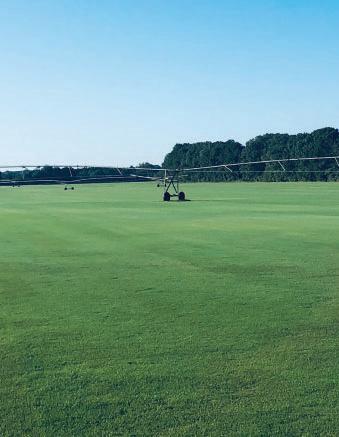











Gary Youmans | Green Acres Turf Farm, LLC, South Carolina













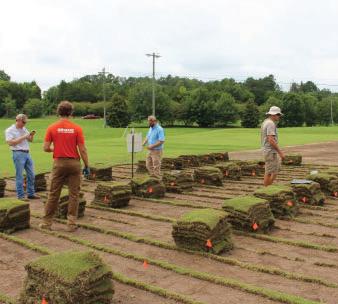




•Worldwide support of growers and industry suppliers
•Annual printed membership directory
•Access to TGIF (Turfgrass Information Files)
•Networking opportunities
...and so much more!
Become a member of TPI and you’ll connect with turfgrass professionals all around the world!
TPI brings similar people, farms, institutions and industry partners together from very different parts of the world to share ideas and information that lead to progress for all. When we all work together we grow and when we isolate ourselves we stagnate. TPI has helped Green Acres Turf Farm grow in many ways that likely would not have happened without the relationships made and information obtained through our TPI membership.



on these international ventures paid off, as that is how Celebration® Bermudagrass and EMPIRE® Zoysia found their way into Sod Solutions portfolio. They moved into online sales, which developed into the Lawnifi brand. Sod Home was born from their education process of helping homeowners. Sod Solutions Professionals came from the desire to build deeper relationships with professional clients. Wagner’s oldest son Drew is very much involved in the business. His first major contribution started with Turf Logistics®, a software management tool to help aid Sod Farms with organizing orders, invoices, harvesting and deliveries. The idea for that came from traveling with his dad and seeing the mountains of paperwork in the offices of the sod farms they visited. Merging his knowledge of the turfgrass industry and software technology, Drew continued contributing ideas that have strengthened the company from within, including Sod Solutions’ new business unit, SatQuote geared especially to the landscape industry.
Tobey and Lee Ann have other members of their family working for the business as well. Their son-in-law, Addison King, is the Chief Financial Officer and he works alongside Lee Ann with the financial department. Their son-in-law, Whit Jacobs, worked as Sod Solutions’ Southeast Territory Manager and is now working on new projects for Innowave, a new division of the company’s Software Technology business unit. Lee Ann and Tobey feel that Sod Solutions employees are an extension of their own family, and their employees feel the same way.
In this ever-evolving business landscape, Tobey and Lee Ann are excited about this 30-year milestone and are confident about the people they will leave the business to. “We feel very blessed to be where we are,” Tobey said. “We’re excited to celebrate our 30th anniversary in 2024 and I truly think the best is yet to come.”
Geri Hannah Welcomes a New Grandson

The following is excerpted from SportsFieldManagementOnline.com
January 24, 2024
Project EverGreen, members of the Sports Field Management Association (SFMA), and the Volusia County Schools teamed up on January 21 at Palm Terrace Elementary School in Daytona Beach to give the school’s long-dormant baseball field and grassy play area a $35,000 makeover. The project was completed in conjunction with the SFMA Conference in Daytona Beach. The goal of the 100,000-square-foot field renovation project was to leave the school and community with a safe, well-maintained, and accessible ballfield and recreation space they can call their own. Project EverGreen works with under-resourced communities to renovate, maintain, and make more accessible healthy playing fields, as well as to improve the environmental health of public green spaces. The 100,000 square feet of grass at the Palm Terrace play field is responsible for sequestering nearly 60,000 pounds of carbon from the air annually which is equivalent to removing 7.5 cars fueled by gas from the road. SFMA supported the renovation project by asking its members to assist with the planning and hands-on renovation work. In-kind donors to the project included TPI members Mountain View Seeds, Profile Products, and SiteOne Landscape Supply. Since 2008, Project EverGreen has renovated more than 100 community parks and restored 200 million square feet of healthy turf across the country.
SFMA Founders’ Award Recipients Announced
Meet Geri and Rodney
Hannah’s grandson, Emmett Fitzgerald
Croxon, born December 28, 2023, weighing 9.4 lbs. Geri and Rodney’s daughter Tasha and her husband Dean Croxon are Emmet’s proud parents. Emmet has an older sister, Harper Hannah Croxon (born April 4, 2020), and an older brother, Connor Maxwell Croxon (born January 29, 2022). The Croxon family lives in Australia.
SFMA’s four founders, George Toma, Dick Ericson, Dr. William Daniel, and Harry Gill, each have an award named after them. (The association, founded as the Sports Turf Managers Association [STMA], was rebranded as the Sports Field Management Association in 2022.) The criterion for each award differs; the intent is to recognize the individual characteristics of these men in each winner. These are surprise awards, announced during the Awards Banquet, held on the last day of the SFMA Conference & Exhibition which, in 2024, was held in Daytona Beach, Florida, January 22-25.
Dick Ericson Award – recognizes a member who effectively manages sports fields and their facility and exhibits the qualities of a true team leader. It was presented to Bill Marbet, Line to Line LLC.
Dr. William H. Daniel Award – recognizes an individual who has made significant contributions to the industry through research, teaching, or extension outreach. It was presented to Kristen Althouse, Pennsylvania Turfgrass Council.
George Toma Golden Rake Award – validates the ‘and then some’ attitude of a sports field member in “on the job” activities and in community service. It was awarded to Dr. Drew Miller of the Brentsville School District Turfgrass Management Program.
Harry C. Gill Founders Award – established to honor an individual for their hard work in the sports field industry and to acknowledge their dedication to STMA. This is the highest award SFMA bestows. It was presented to David Pinsonneault, CSFM, CPRP, CPWP-M, Lexington Department of Public Works.


The latest version of the ultimate, one-man turf harvesting machine.





4-way camera screen

Improved power rollup

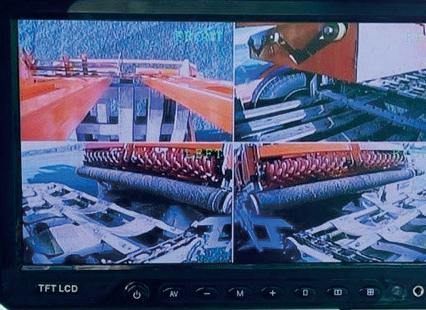

Updated, user-friendly controls with onboard diagnostics


The new TSS Slab takes production and reliability to new levels. New upgrades, including hardware and software updates, for 2024.




The new TSR Roll offers our latest technology to boost your efficiency. This machine features a newly improved rollup system for 2024.
To boost your bottom line, contact Trebro today!
The Turfgrass Water Conservation Alliance (TWCA) provides the following, summarizing their end of 2023 report: From improving the process to expanding the Turf Trade footprint TWCA continues our commitment to improvement. One area is Faster Qualification.
This year TWCA is streamlining the qualification. Producer members have access to trial reports before the new year! Qualification reports will be issued to Producer members in early February with public release in March. These longer lead times help members position cultivars for production and marketing. 140 Days
Until Public Qualification.
Research Support
TWCA’s commitment to direct action is on full display! Our goal is to provide direct incentives to researchers who share our passion for this important cause. We believe that by working together, we can make a real difference. We are proud to be a part of this effort and look forward to continuing our support for years to come. A special Thank You to the following for their partnership and for all that they do to promote water conservation in the turfgrass industry. Travis Roberson - Estimating Golf Course Irrigation Efficiency
Using Thermal Aerial Imagery. – Virginia Tech. Karem Meza Capcha - Spatial Estimation of Actual Evapotranspiration and Turfgrass Quality on Golf Courses Using Remote Sensing Information. - Utah State University. Michael Rabe - Comparing Variable depth and Capillary Hydroponic system Rootzones for sustainable Putting Green Management. - Michigan State University.
The following provided posters to illustrate their work in water conservation: Antonio Verzotto - Cool-Season Species Response to Four Lawn Irrigation Programs in the Midwest – Purdue University. William Errickson - Needs Assessment for Remote Sensing- and Machine Learning-Guided Precision Turfgrass Irrigation Programs: Findings from a Socioeconomic SurveyRutgers University. Ashley Beazer - Cool Season Hybrid Bermudagrass: Drought Tolerance Compared to Kentucky Bluegrass - Brigham Young University
SiteOne® Offers Newest PBI-Gordon Herbicide
In a press release issued January 22, 2024, SiteOne® Landscape Supply reported it now offers ArkonTM Herbicide Liquid, the newest solution from PBI-Gordon for post-emergent control of sedges, kyllingas and other broadleaf weeds.
Approved in 2023 by the Environmental Protection Agency for use in most U.S. states except California and Alaska, Arkon is labelled for application on established cool- and warm-season turfgrass species across a wide range of landscapes, including sod farms, residential and commercial lawns, golf course greens, fairways and roughs, and other sports facilities.
“At SiteOne, we are always looking for new products to help our customers better serve their customers and clients,” said Kevin Laycock Director of Category Management for Agronomics. “Arkon is one of the newest broadleaf herbicides available, and we are very proud to be able to offer it to the hardworking landscape and golf professionals who depend on SiteOne.”
Arkon products are restricted and can be sold only to licensed lawn care operators in accordance with their state laws. To purchase or to learn more about Arkon herbicide, visit SiteOne at www.SiteOne.com.

In an email issued on January 5, 2024, Bethel Farms announced a new website, https://biminibermuda.com with the following statement:
Check out our website to explore the BIMINI® grower network and see how BIMINI’s toughness and resilience is ideal for everything from sports fields to residential lawns!
The following was provided in a January 22, 2024, email from Dr. Allen Sills, NFL Chief Medical Officer.
The NFL is constantly working to harness the latest innovations to advance player health and safety. One key piece of our efforts is the Digital Athlete, an injury prediction tool built on artificial intelligence and machine learning that represents the future of insight and injury prevention.
Beginning this season, all 32 NFL clubs had access to the Digital Athlete team portal, which includes daily training volume and injury risk information for their players, plus league-wide trends and benchmarks. Information in the portal allows club staff to work more efficiently by providing regular, automated insights into which players are at the highest risk of injury and which can increase their training load – informing proactive adjustments to practices and game plans.
The Digital Athlete equips coaches and training staff to make data-driven decisions by providing a complete view of an NFL player’s experience. The tool takes video and data from training, practice, and in-game action and uses Amazon Web Services AI and machine learning technology to run simulations of specific NFL game scenarios that indicate which players are at the highest risk of injury. The insights from these simulations can help inform the development of individualized injury prevention, training, and recovery regimens for players.
The Digital Athlete tool is one piece of the NFL’s efforts to leverage on-field data to better inform player health and safety efforts. Innovations in player equipment such as sensors in mouthguards and shoulder pads provide the league with data from practices and games to advance equipment and training and inform rules changes. Data collected from sensors has fueled efforts to remove avoidable head impacts and is being used to evaluate further changes to the kickoff play. The technology has also enabled changes to the preseason ramp-up period, which have led to a substantial reduction in lower extremity injuries—keeping players healthy and on the field.
We look forward to continuing to share how these innovations and others are providing clubs with a better understanding of players’ experiences and informing our efforts to reduce injury risk. Videos demonstrating the use of this technology can be found on the National Football League website: www.nfl.com
The Hill Email News Alert By Saul Elbein, issued on January 24, 2024, reported that many of America’s critical sources of underground water are in a state of rapid and accelerating decline, a new study has found. More than half of the aquifers in the United States (53 percent) are losing water, according to research published Wednesday in Nature. And in about 1 in 8 American aquifers— roughly 12 percent—the collapse of underground water levels has sped up during the 21st century, the researchers found.
“Groundwater levels are declining rapidly in many areas,” co-author Scott Jasechko of the University of California, Santa Barbara, told The Hill. “And what’s worse, the rate of groundwater decline is accelerating in a large portion of areas,” Jasechko said.
The impacted aquifers support much of the U.S. food system, as well as providing water used by many Americans. And the country is not alone in its losses: The study found rapid loss of water in aquifers that supply hundreds of millions of people worldwide. But the researchers added that these grim findings came with a bright spot: Many once-declining regions have bucked the trend. “Long term groundwater losses,” they wrote, “are neither universal nor inevitable.”
Hydrologists talk about aquifers in terms of “shallowing” and “deepening”—that is whether groundwater is getting closer to or further from the surface.
The study addressed many of the causes and consequences of the decline, but it also pointed to potential solutions that are stopping, and even reversing, the decline. “Given ‘clever,’ locally relevant interventions, with adequate scope and scale—we can make things better. Groundwater depletion is not inevitable,” Jasechko said.
The following is excerpted from a report written by Jack Falinski at MSU A newly released climate report spearheaded by the Lawrence Livermore National Laboratory in Livermore, California, and sponsored by the U.S. Department of Energy, or DOE, spotlights research conducted by several distinguished Michigan State University scientists.
The report, called “Roads to Removal: Options for Carbon Dioxide Removal in the United States,” provides an in-depth analysis of ways the U.S. economy can become net-zero in greenhouse gas emissions by 2050, a goal established by the U.S. government in 2022. In parallel with priorities to decarbonize the U.S. energy, industrial, and agricultural sectors, the report examines strategies on how to remove carbon dioxide from the atmosphere.
The report, in part, documents research led by MSU scientists Bruno Basso and Phil Robertson into how carbon dioxide can be captured from the atmosphere using bioenergy and cropland-soil management solutions.
This first-of-its-kind report evaluates different approaches for removing carbon dioxide from the atmosphere at a national level in terms of both cost and capacity.
“Worth noting is the novelty of this analysis,” said Robertson, a University Distinguished Professor in the Department of Plant, Soil and Microbial Sciences. “This is the first large scale analysis of carbon dioxide removal for the entire country that brings together all technologies in one place and places them in an economic context.”

The research shows at a county level the potential for economically viable carbon to be removed from the atmosphere and used for bioenergy or sequestered in soil.
Researchers looked at the benefits of growing perennials — plants like switchgrass — that might be grown in unprofitable and nonproductive parts of crop fields. The question became: How much carbon can we pull and store into the soil if we grow perennial crops for bioenergy?”
The goal of this study was to not compete with land used for agriculture or pasture grazing. The study evaluated how marginal land with low agricultural value could be implemented.
Another scenario where these perennial crops could be grown is on land enrolled in the Conservation Reserve Program, a federal program administered by the U.S. Department of Agriculture Farm Service Agency, or the USDA FSA. Farmers can receive a yearly rental fee for planting environmentally advantageous species on their land that is sensitive to agricultural production.
It also concluded that using cropland-soil management solutions — in addition to those involving forest management, biomass carbon removal and storage, and direct air capture — could allow for even more carbon to be stored beyond the one billion metric ton per year benchmark.
In addition to these benefits, farmers can also improve soil fertility and restore biodiversity to ecosystems by planting perennial crops. According to the report, cropland-soil and forest management solutions are steps that can be taken immediately to remove carbon dioxide from the atmosphere due to their rapid scale-up potential and low implementation costs.
To view the full report, visit roads2removal.org
Which Foreign Country Owns the Most Farmland in the U.S.? Hint: It's Not China
The following appeared in The Daily Scoop, an online newsletter on January 4.
Controversy continues to grow across the U.S., and China is the primary target of the new rules. However, China doesn’t own the most farmland in the U.S., according to a new USDA report. It’s actually Canada, which accounts for 32 percent, or 14.2 million acres (5.7 million hectares).
Rounding out the top five are the Netherlands at 12 percent, Italy at 6 percent, the United Kingdom at 6 percent, and Germany at 5 percent. Together, citizens in those countries hold 13 million acres (5.3 million hectares), or 29 percent, of the foreign-held acres in the U.S. China owns less than 1 percent, or 349,442 acres (141,414 hectares).
All told, 43.4 million acres (17.6 million hectares) of forest and farmland in the U.S., or 3.4 percent of all ag land, is foreign owned as of December 31, 2022. Roughly 30 million of those acres (12.1 million hectares) are reported as foreign-owned, with the remainder primarily under a 10-year-or-longer lease. Of the 30 million, 66 percent is owner-operated, 14 percent has a tenant or sharecropper as the producer, and 12 percent report a manager other than the owner or a tenant/sharecropper as producer. The remaining 7 percent are “NA.”
The link to the full article is shown below.
https://www.thedailyscoop.com/news/retail-industry/which-foreigncountry-owns-most-farmland-us-hint-its-not-china eign-

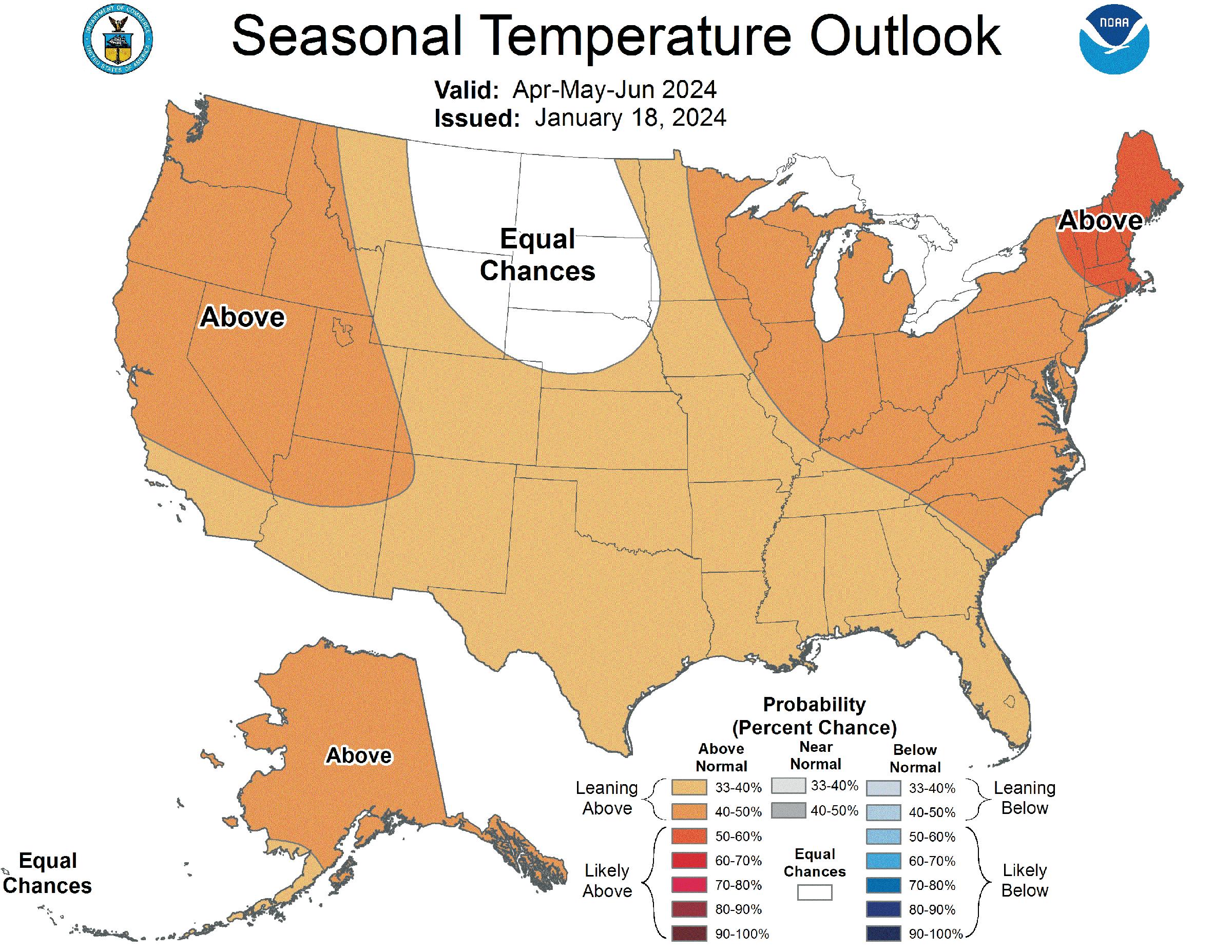


ECOCYCLE™ SOD NET
17' & Standard Width
20' Widest Roll on the Market
6" and 8" Poly Cores
Available in Green or Brown
Standard Strength and Heavy Duty
ECOCYCLE™ SOD WRAP
23" 29" 40" and 46"
Sports Net-Stronger for Heavier Rolls
Extra Length
Standard Strength and Heavy Duty
Each roll individually wrapped for protection
PALLET NET WRAP
Provides breathability and air flow
Keep integrity of rolls during transport
Hand rolls for easy application

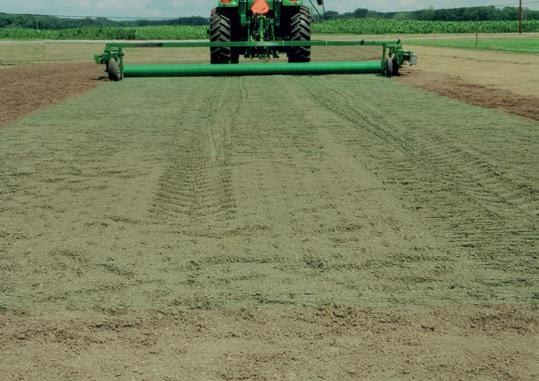



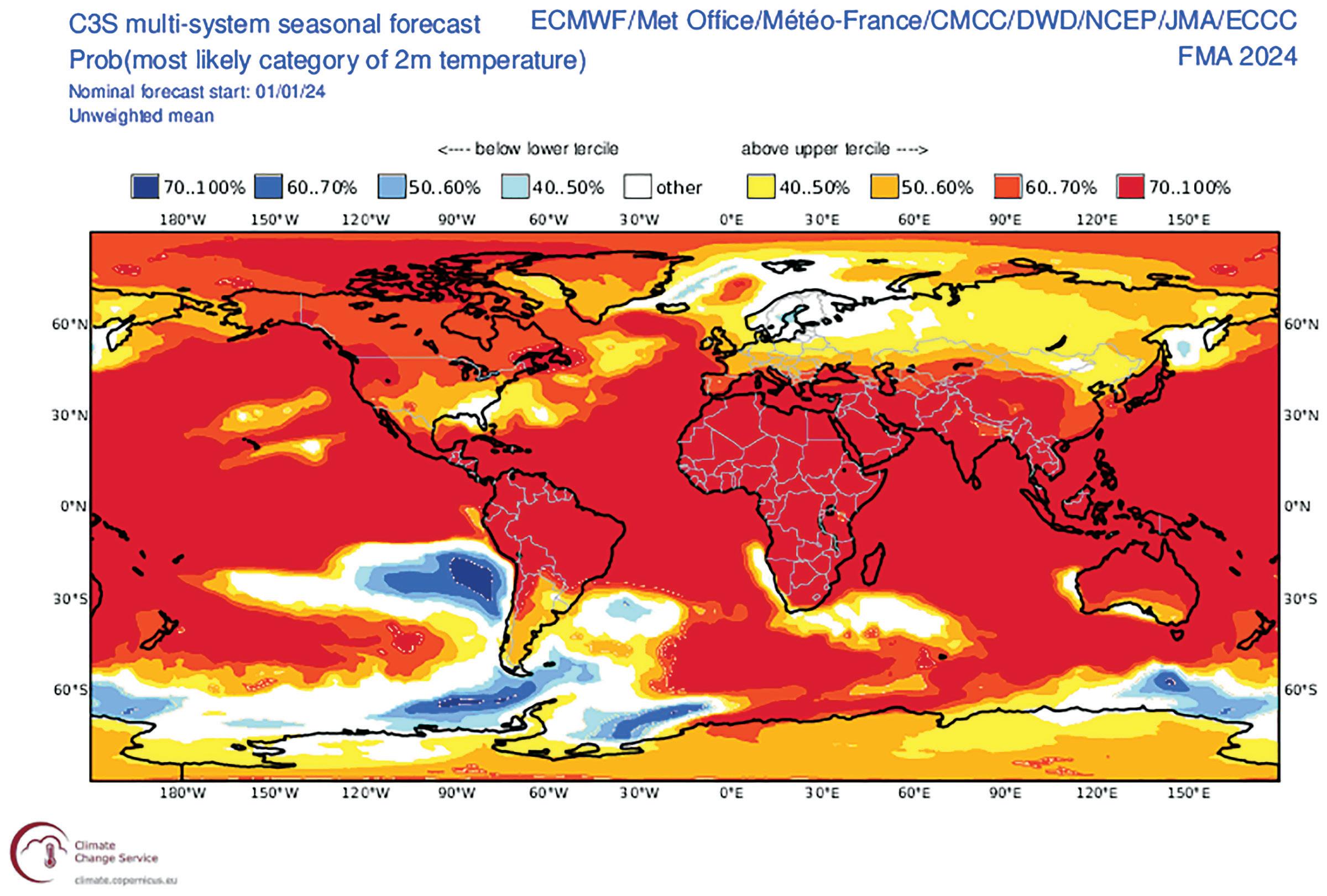
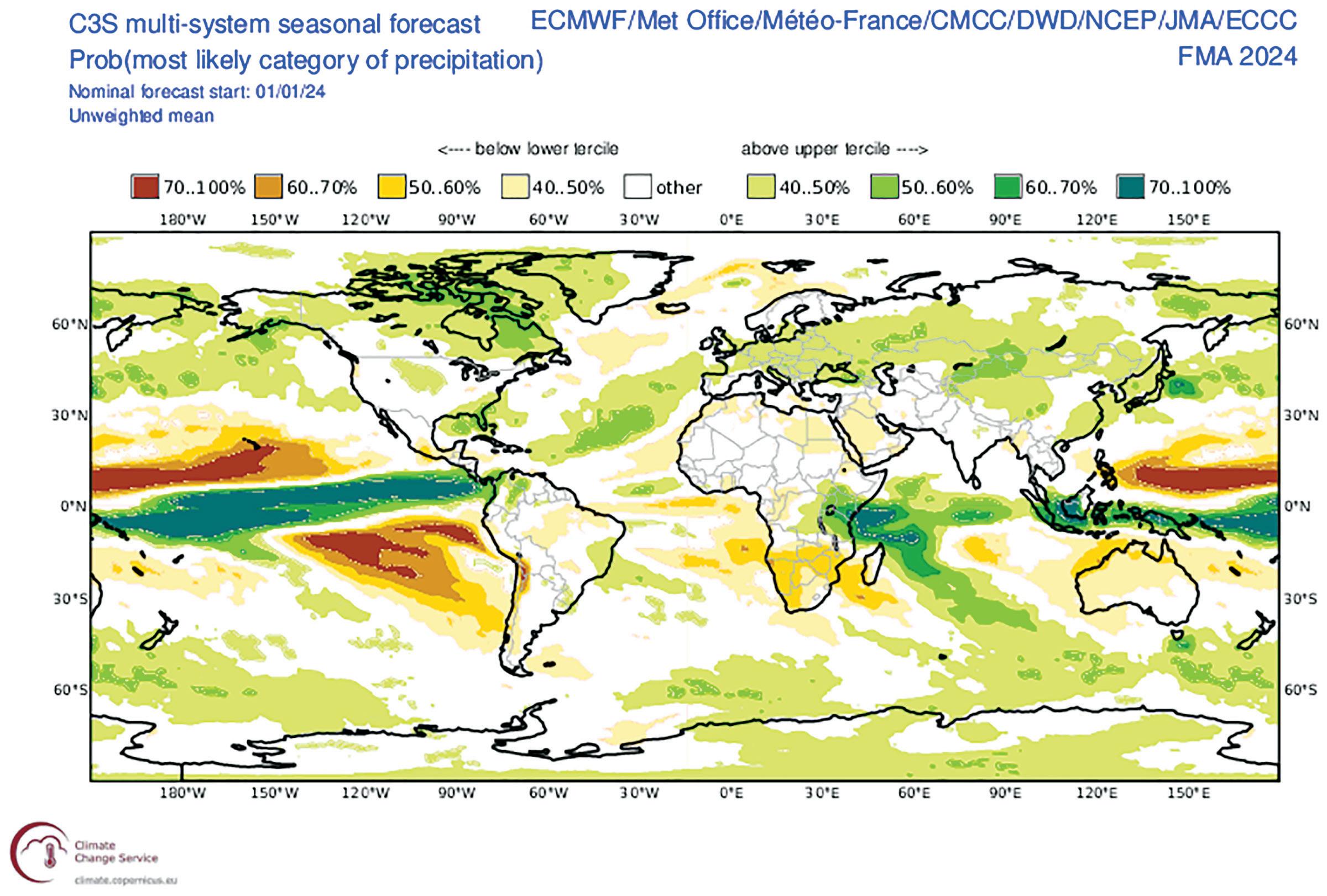












































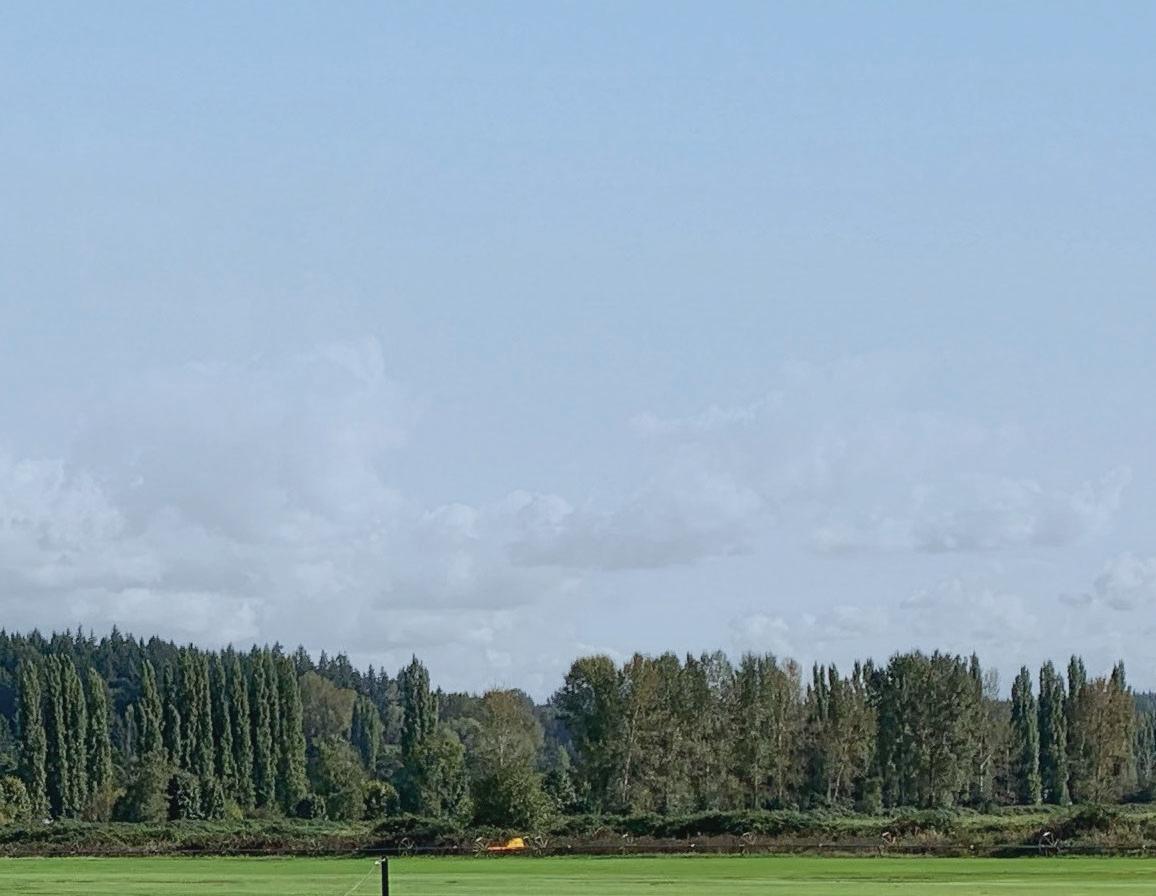









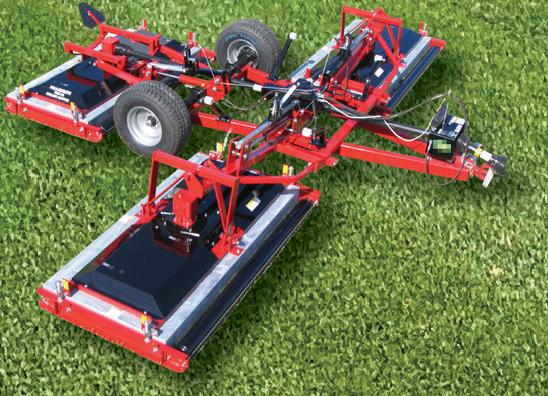



































The Australian Government Bureau of Meteorology (http://www.bom.gov.au) is Australia's national weather, climate, and water agency. Its expertise and services assist Australians in dealing with the harsh realities of their natural environment, including drought, floods, fires, storms, tsunami, and tropical cyclones. BOM provides regular forecasts, warnings, monitoring, and advice spanning the Australian region and Antarctic territory. It contributes to national social, economic, cultural, and environmental goals by providing observational, meteorological, hydrological, and oceanographic services and by its ongoing research.
The national seasonal median rain forecast map above is just one example of the predictive weather-related tools available. As the website states, these maps display automated forecasts from computer models. They may differ from the Bureau's official forecasts including BOM MetEye (your eye on the environment), text forecasts, and the BOM Weather app which consider other sources of information and are fine-tuned by meteorologists. The BOM Weather App provides access to hourly and seven-day forecasts, radar data, and weather warnings.























FOR SALE: 2014 Magnum 42SRA, 42" cutting width, 2960 hrs., Ready to go to the field and work. This machine has been well kept. Hours will change slightly as they're still using it. Machine will be available late March and is located in AR. Asking $185,000.
Please contact Colton at colton@salesmidwest.com or call 913254-9560.
FOR SALE: Well-maintained McFarlane Stalk chopper and seedbed conditioner. Model SPR 1000-5, which in newer models would be a SPR 1030-5. The Reel Seedbed Conditioner is a multipurpose field preparation tool used for managing stalks and/or preparing fields for planting. Size residue in the fall to speed decomposition. In the spring, cut, mix, and spread residue on top of the field. Uniform soil density is maintained when leveling fall-tilled fields or when breaking crusted soils. Plant earlier in damp, cold soils by exposing the soil and accelerating soil warming. With operating speeds up to 10 mph, many acres are covered quickly. Has about 800-1000 acres on unit. Used to prep seedbeds for sod fields. Feathering boards are in good condition. Consumable blades will need to be changed in about two seasons. Chopping blades need to be replaced, if you'd like I can change them, and the price would go up to $13,500 or $10,000 as is. If you would like to see it in action, please visit the following YouTube link: https://www. youtube.com/watch?v=w7C_cytn2W4
Please contact Robert at turpinarms@gmail.com or 513-617-3623.
FOR SALE: Progressive Mower for Sale. Model TD-92. 22' wide. Asking $8,000.
Please call Bob at 630-557-2900.
FOR SALE: Brouwer SPI Big Roll Sod Installer. Can handle both 24" & 30" rolls. Like New. Only used for demo's. Asking $8,000.00. Please call Bob at 630-557-2900.
FOR SALE: John Deere 6410. MFWD. Purchased new in 2000. Now has 4,327 hours. Used primarily for mowing. Asking $32,000.00
Please contact Bob at 630-557-2900.
FOR SALE: 2000 Princeton D50 Piggyback Forklift. 3WD. Used primarily as field fork w/8,127 hours. One owner. 120" mast w/ sideshift. Asking $19,000.00
Please call Bob at 630-557-2900.
HELP WANTED: Central Sod Farms of Maryland, Inc is a 1700acre sod farm with several locations in Maryland. We grow five types of turfgrass and ship them throughout the Mid-Atlantic. We are a small yet successful business, currently with around 40 employees.
We are looking for a business manager to oversee a very broad collection of responsibilities. As is typical with most agricultural operations, we do work longer hours than traditional businesses.
Responsibilities:
• Develop and implement strategic plans to grow the sales of current and new products
• Formulate business goals, make plans, and lead yourself and others to achieve them
• Conduct sales / marketing / customer service meetings
• Manage client accounts and build strong relationships with key stakeholders
• Stay updated on market trends and industry developments
• Identify and pursue new business opportunities to expand the client base
• Foster our culture of continuous improvement, quality, and automation both in the office and the field
• Oversee the general day to day operations in the office
• Hire and mentor other employees to fulfill their greatest potential
• Ensure compliance with regulatory requirements and internal policies
Qualifications:
• Bachelor's degree in finance, accounting, farm management, agriculture, or significant equivalent experience
• Strong sales and account management skills
• Experience with Quickbooks or other accounting software
• Excellent analytical skills and attention to detail
• Familiarity with concepts related to agricultural production
• Ability to communicate effectively with both clients and co-workers
• Strong problem-solving and decision-making abilities
• Proactivity and possession of a growth mindset with the drive to continually improve both yourself and others
• Sod farming experience is a huge plus, but we will train the right person
We offer competitive compensation packages, including health insurance, paid time off, paid holidays, retirement plans, and professional development opportunities.
Salary: 90-130k per year - Relocation assistance available
Call Jack at 443-433-8737 or email jack@centralsodmd.com with any questions!
FOR SALE: 2019 Trebro TSR: SN: TSR-149, Engine hours: 3627
Harvest hours: 1610
Ready to go to work. Customer is only selling because they upgraded their harvesters; Location: TX. Asking:$229,000.
Please contact Colton at 913-254-9560 or email: colton@ salesmidwest.com.
FOR SALE: 2015 Magnum 420SRA; 42"Automated big roll machine; Always stored in the barn, runs like it should. Asking $170,000.
Please contact Colton at 913-254-9560 or email: colton@ salesmidwest.com.
FOR SALE: 2020 BROUWER ROBOMAX 24JD; Hours: 2055; Lightly used machine, good condition, ready to go to the field to work. Asking $240,000.
Please contact Colton at 913-254-9560 or email: colton@ salesmidwest.com.
FOR SALE: Brouwer 4000, 1050 hrs., in Sheffield, MA. Please call for more pictures and with any questions. Asking price $250,000.
Contact: Bruce Goodchild at sheffieldsodfarm@gmail.com or call 413-347-6714.
FOR SALE: Brouwer 1560 Rollmax, 24” big roll harvester. 1339 hrs. Located at DeBuck’s Sod Farm, Michigan. Asking $19,500. Please contact Greg Mischel at 313-510-2004 for more information.
FOR SALE: Brouwer 1560 24” big roll harvester with autosteering and nettings. Located at DeBuck’s Sod Farm, Michigan. Asking $19,500.
Please contact Greg Mischel at 313-510-2004 for more information.
FOR SALE: Three (3) Brouwer 24” big roll attachments. Two have skid steer plates and one has a 3-point hitch. Located at DeBuck’s Sod Farm, Michigan. Asking $1,500/each.
Please contact Greg Mischel at 313-510-2004 for more information.
Turfgrass
International ……......................…... 3, 51, 61
Van Vuuren Machines …….....................................................…41
Buying or selling equipment, supplies, properties, or looking for employees or employment opportunities?
TPI classified advertising is the answer! Reach your target market with a free or low cost classified ad in Turf News magazine and on the TPI website at www.TurfgrassSod.org.
The classified ad section is the first place many TPI members look when they receive the most recent issue of Turf News magazine and the most viewed area on the TPI website. All classified ads are posted to the TPI website within 24 hours of approval and featured in the next issue of Turf News!
TPI Member: FREE / Non-Member: $50
Rates are determined in one-inch vertical increments.
Please estimate approximately 65 words per inch. Photos are limited to the website and no more than two photographs per ad.
View full details at www.TurfgrassSod.org/classifieds
Deadline:
30-days prior to Turf News issue date (e.g., May/June Turf News issue, ad is due by April 1).
Upload your classified ad at: www.TurfgrassSod.org/classifieds or send to Geri Hannah via email: GHannah@TurfgrassSod.org
fax: 847-649-5678
mail: Turfgrass Producers International
444 E. Roosevelt Road #346 | Lombard, IL 60148 U.S.A
All classified ads are subject to review; TPI does not endorse any ad and reserves the right to edit or decline any ad.
Brian Walker
Innovative Ag
PO Box 67
Lamar, IN 47550
804-432-6383
Corey Mitchell Fordyce
Marian Lawns
107 Brand Road
Marian, Queensland, Australia
admin@marianlawns.com.au
+61 488 267
393
Jonathan Lallement
Star Turf Farms LLC
PO Box 100
Belle Glade, FL 33430
jlallement@StarTurf.com
561-261-1888
Jeff.hill@usa-sod.com
713-398-4975

Editor’s note: The following information was up to date as of January 31, 2024. Please check the websites listed for the most current information as you do your planning.
2024
APRIL
April 18-19
TPF Growing Better 2024
Parrish, FL
https://floridaturf.com/2024-growing-better/
MAY
May 20-23
Turf Australia Conference
Darwin, Australia
2024 Conference Website coming soon
JUNE
June 15-19
American Seed Trade Conference
Nashville, TN
https://www.betterseed.org/events/asta-events/
JULY
July 14-16
Texas Turfgrass Association Summer Conference
Round Rock, TX
https://texasturf.com/index.php/2024-summer-save-the-date/
OCTOBER
October 14
Turfgrass Producers of Texas Fishing Tournament
Matagorda, TX
https://texasgrass.com/events/
October 15-18
EQUIP Expo
Louisville, KY
https://www.equipexposition.com
October 17-18
European Turfgrass Producers Event
Rome, Italy
https://turfgrassproducers.eu/category/event/
October TBD
TPI Study Tours
Rome, Italy
Registration opens soon!
NOVEMBER
November 3-6
ELEVATE National Landscape Conference
Charlotte, NC
https://www.landscapeprofessionals.org/ELEVATE
November 4-7
Irrigation Show and Education Week
Long Beach. CA
https://www.irrigation.org/2024show
November 11
Turfgrass Producers of Texas Golf Tournament
Bay City, TX
https://texasgrass.com/events/
November 18-20
Carolinas Golf Course Superintendents Association Conference
Myrtle Beach, SC
https://www.carolinasgcsa.org
November 20
SC Sod Producers Association Meeting
Myrtle Beach, SC
2025
JANUARY
January 12-16
Sports Field Management Association Conference
Palm Springs, CA
https://www.sportsfieldmanagement.org/conference/
FEBRUARY
February 1-6
Golf Industry Show (GIS)
San Diego, CA
https://gcsaaconference.com
February 9-13
TPI International Education Conference & Field Day
San Antonio, TX

https://www.turfgrasssod.org/ events/

If you are planning an industry event of interest to our readers please send the information to: CReynolds@TurfgrassSod.org and put “Industry Calendar” in the subject line.



























